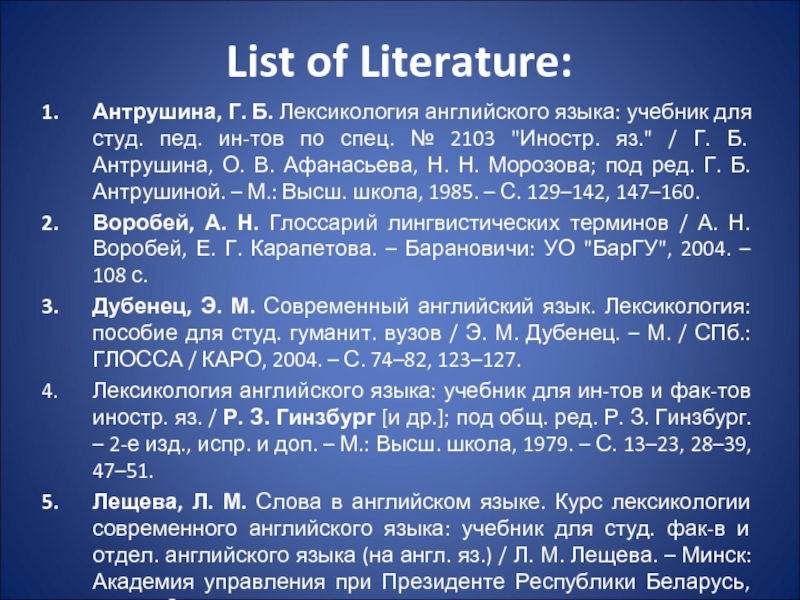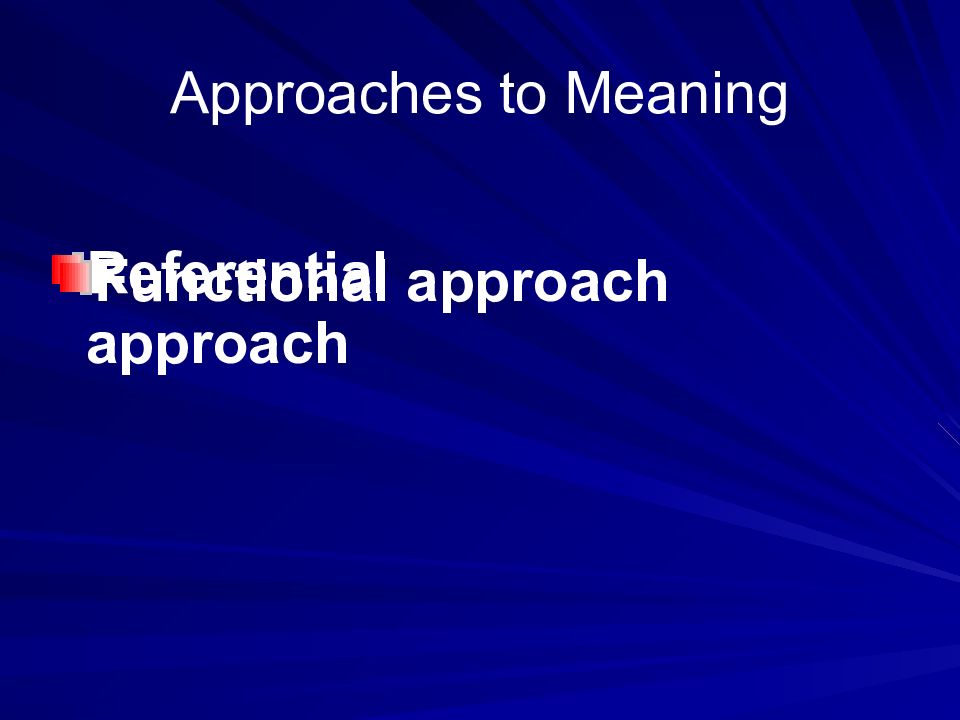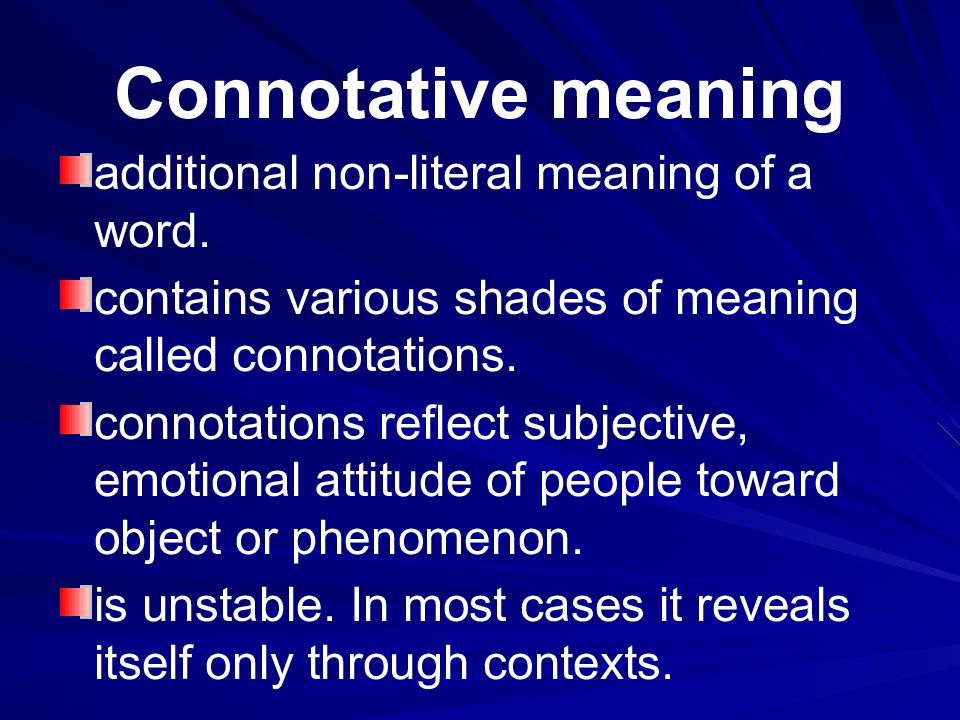Word-meaning is made up of
various components described as meaning types. There are several
types of meaning.
Lexical
meaning is the meaning proper to the given linguistic unit in all its
forms and distributions.
The most significant features of the lexical meaning of the word are:
the word’s interrelationship with the denoted objects and phenomena
of the world; the word’s interrelationship with the conceptual
matter that appears in people’s mind on perceiving a language unit;
the word’s interrelationship with the other words in a context so
lexical meaning possesses several aspects.
According
to D.
Crystal,
lexical
items are viewed upon as signs within the sign system of the language
vocabulary
so
signification
is that aspect of the word’s meaning which stresses the sign
function of the word, in other words, it is the relation between sign
and thing or sign and concept.
Denotation
involves the relationship between a linguistic unit (a lexical item)
and the non-linguistic entities to which it refers. Denotational
meaning is the part of lexical meaning that makes communication
possible. Denotational
meaning conceptualises
and classifies our experience and names objects so that our knowledge
of reality is embodied in words having essentially the same meaning
for all speakers of the language. Denotational meaning can be
segmented into semes
(seme is a minimal unit of the matter).
This procedure is known as componential analysis which seeks to set
up minimal semantic oppositions in order to arrive at meaning
differentiating features.
When words are used in their
factual direct meanings denotation and signification coincide
Connotational
meaning comprises the emotive charge and the stylistic value of the
word that are closely connected and even interdependent. In
other words, connotation is supplementary emotive, evaluative,
expressive and stylistic shade which is added to the word’s
denotational meaning and which serves to express the emotional
content of the word — that is its capacity to evoke or directly
express emotion.
The
list and specification of connotational meanings varies with
different linguistic schools and individual scholars and includes
such entries as pragmatic
(directed at the perlocutionary effect of utterance), associative
(connected, through individual psychological or linguistic
associations, with related and non-related notions), ideological,
or conceptual (revealing
political, social, ideological preferences of the user), evaluative
(stating the value of the indicated notion), emotive
(revealing the emotional layer of cognition and perception),
expressive
(aiming at creating the image of the object in question), stylistic
(indicating «the register», or the situation of the
communication).
Let’s
illustrate four
main components of connotational meaning: emotive,
evaluative, expressive (intensifying), stylistic.
Emotive
meaning or charge is associated with emotions.
In the following sets of words with the same denotational meaning to
like, to love, to worship; big, large, tremendous; girl, girlie;
dear, dearie — to
worship, tremendous, girlie, dearie
have
heavier emotive charge than others members of sets. We shouldn’t
confuse the emotive
charge
with emotive
implications:
what is thought and felt when the word hospital
is used by an architect who built it, a doctor or a nurse working
there, the invalid staying there after an operation.
Evaluative
meaning expresses approval or disapproval, e.g.,
magic
has
attractive connotation while its synonym witchcraft
has sinister accentuation.
Expressive
component serves to
emphasise
the subjective attitude to the content of the utterance or the person
addressed, e.g.,
magnificent,
splendid, superb
may be viewed as exaggerations.
Stylistically
words
can be subdivided into literary
(bookish), neutral and colloquial layers (parent
— father — dad).
Literary
words can be subdivided into general literary words (harmony,
calamity);
scientific terms; poetic words and archaisms (albeit
— although);
barbarisms and foreign words (bon
mot — a clever or witty saying, bouquet). The
colloquial words may be subdivided into common colloquial (dad);
slang (gag
for a joke);
professionalisms (lab); jargonisms (a
sucker — a person who is easily deceived);
vulgarisms (shut
up);
dialectical words (lass);
colloquial coinages (allrightnik).
The
above-mentioned meanings are classified as connotational not only
because they supply additional (and not the logical / denotational)
information, but also because, for the most part, they are observed
not all at once and not in all words either. Some of them are more
important for the act of communication than the others. Very often
they overlap (частично совпадают). So, all words
possessing an emotive meaning are also evaluative (rascal,
ducky),
though this rule is not reversed, as we can find non-emotive,
intellectual evaluation (good,
bad).
Also, almost all emotive words are also expressive, while there are
hundreds of expressive words which cannot be treated as emotive
(take, for example the so-called expressive verbs, which not only
denote some action or process but also create their image, as in to
gulp — to swallow in big lumps, in a hurry; to sprint — to run fast).
The number, importance and the
overlapping character of connotational meanings incorporated into the
semantic structure of a word, are brought forth by the context, i. e.
a concrete speech act that identifies and actualizes each one. More
than that: each context does not only specify the existing semantic
(both denotational and connotational) possibilities of a word, but
also is capable of adding new ones, or deviating rather considerably
from what is registered in the dictionary. Because of that all
contextual meanings of a word can never be exhausted or
comprehensively enumerated.
Grammatical
meaning is the component of meaning recurrent in identical forms of
individual forms of different words.
On the one hand, grammatical meaning unites words in such large
groups as parts of speech, e.g., the grammatical meaning of
substuntivity
for
nouns, the grammatical meaning of process
for
verbs, and so on. On the other hand, it is the property of identical
sets of word-forms. It may be defined as the indication in certain
grammatical categories, e.g., such word-forms as tables,
books
manifest the grammatical meaning of plurality. Grammatical meaning
may also de defined as the realization of a concept or a notion by
means of a definite language system, e.g., the word forms go,
goes, went, gone, going
express one and the same concept, that of the process of movement,
which is restricted in their lexical meaning. It follows that by
lexical meaning we understand the meaning proper to the linguistic
unit in all its forms, by grammatical meaning we understand the
meaning proper to the sets of word-forms common to all words of a
certain class, e.g., the word takes
has the same lexical meaning as took,
taken,
but its grammatical meaning is that which is shared by works,
stands;
the same is true about grammatical meaning of the following examples:
boys, girls; boy’s, girl’s; helped, met; better, smaller.
Соседние файлы в предмете [НЕСОРТИРОВАННОЕ]
- #
- #
- #
- #
- #
- #
- #
- #
- #
- #
- #
Semasiology — the branch of linguistics concerned with the meaning of words and word equivalents.
(Greek) semasia — signification (значение, смысл) and logos — learning.
Изображение слайда
2
Слайд 2: The main objects of semasiological study:
types of lexical meaning
polysemy and semantic structure of words
semantic development of words
the main tendencies of the change of word-meanings
semantic grouping in the vocabulary system (synonyms, antonyms)
semantic fields
Изображение слайда
3
Слайд 3: Approaches to Meaning
Referential approach
Functional approach
Изображение слайда
4
Слайд 4: Referential approach to meaning
The meaning is in some form or other connected with the referent (object of reality denoted by the word).
The meaning is formulated by establishing the interdependence between words and objects of reality they denote.
The meaning is often understood as an object or phenomenon in the outside world that is referred to by a word.
Изображение слайда
5
Слайд 5: Functional approach to meaning
Words are studied in context; a word is defined by its functioning within phrase or a sentence.
The meaning of linguistic unit is studied only through its relation to other linguistic units.
The meaning is viewed as the function of a word in speech.
Изображение слайда
a category of human cognition (понятие, идея; общее представление; концепция).
the thought of the object that singles out the most typical, the most essential features of the object.
Изображение слайда
7
Слайд 7: the concept of » a building for human habitation »
English
house
«fixed residence of family or household» −
home
Ukrainian
дім
домівк a
Изображение слайда
8
Слайд 8: The difference between meaning and concept:
Concepts are always emotionally neutral
Meaning of many words not only conveys some reflection of objective reality but also the speaker’s attitude to what he is speaking about, his state of mind.
The concept of size: big / large / tremendous
Изображение слайда
(thought or reference)
Concept
Word —————— Referent
(symbol) (object denoted
by the word)
Изображение слайда
10
Слайд 10: The branch of linguistics which specializes in the study of meaning is called semantics
Meaning is a certain reflection in our mind of objects, phenomena or relations that makes part of the linguistic sign − its so-called inner facet (аспект, грань, сторона), whereas the sound-form functions as its outer facet.
Изображение слайда
11
Слайд 11: grammatical and lexical meanings
Grammatical meaning − the expression in speech the relationships between words.
Lexical meaning − the realization of concept or emotion by means of a definite language system.
Изображение слайда
12
Слайд 12: three types of lexical meaning of words:
1. Nominative meaning determined by reality. The direct nominative meaning stands in one-to-one relationship with a word. cat, table, sun
2. Phraseologically bound meaning of words depending on the peculiarities of their usage in a given language, e.g. to take care, to have a smoke, to catch a cold.
Изображение слайда
3. Syntactically conditioned meanings
of words are those which change with the change of the environment. Compare the following verbs:
«to look» — to look for— to look after
Изображение слайда
14
Слайд 14: The structure of lexical meaning of a word
denotative meaning
connotative meaning
Изображение слайда
15
Слайд 15: Denotative meaning
a linguistic expression for a concept or a name for an individual object.
makes communication possible.
is bound up with its referent.
may have one constant referent – a moon
may have several referents — a hand
Изображение слайда
16
Слайд 16: Connotative meaning
additional non-literal meaning of a word.
contains various shades of meaning called connotations.
connotations reflect subjective, emotional attitude of people toward object or phenomenon.
is unstable. In most cases it reveals itself only through contexts.
Изображение слайда
17
Слайд 17: four main types of connotations:
stylistic connotation is what the word conveys about the speaker’s attitude to the social circumstances and the appropriate functional style ( slay vs kill )
emotional connotation conveys the speaker’s emotions ( mummy vs mother )
Изображение слайда
evaluative connotation may show his approval or disapproval of the object spoken of ( clique vs group )
expressive/intensifying connotation is conveyed by degree of intensity (adore vs love)
Изображение слайда
the denotative component of the lexical meaning of the word is «frightening“.
the expressive or intensifying connotation is «very, very good» or «very great»:
terrific beauty, terrific pleasure
Изображение слайда
It is the connotative meaning in a word which helps create irony, sarcasm, metaphor and other figures of speech.
Изображение слайда
the ability of words to have more than one meaning.
A word having several meanings is called polysemantic and most English words are like this.
Изображение слайда
1) a flat horizontal slab or board, usually supported by one or more legs, on which objects may be placed
2) a) such a slab or board on which food is served we were six at table b) (as modifier) table linen c) (in combination) a tablecloth
3) food as served in a particular household or restaurant
4) such a piece of furniture specially designed for any of various purposes
5) a) a company of persons assembled for a meal, game, etc b) (as modifier) table talk
6) any flat or level area, such as a plateau
7) a rectangular panel set below or above the face of a wall

9) an upper horizontal facet of a cut gem
10) music the sounding board of a violin, guitar, or similar stringed instrument
Изображение слайда
23
Слайд 23: Change of lexical meaning in words
linguistic
— the influence of linguistic environment
— analogy
— the context
extra-linguistic
— cultural
— social
— psychological
Изображение слайда
24
Слайд 24: ways of change of word-meaning:
1. extension of meaning (generalization);
2. narrowing of meaning (specialization);
3. transference of meaning (metaphor and metonymy);
4. elevation of meaning (amelioration);
5. degradation of meaning (pejoration).
Изображение слайда
25
Слайд 25: 1. Extension /expanding of meaning (or generalization)
In the process of extension a word-meaning may acquire a higher degree of abstraction or more generalized character.
“manuscript” originally meant only something handwritten. Now it refers to any copy either written by hand or printed.
Изображение слайда
26
Слайд 26: 2. Narrowing of meaning/contraction, (specialization)
In the process of narrowing, a word-meaning acquires a specialized sense in which it is applicable only to some of the objects or phenomena it previously denoted.
a corpse — a human or animal body, living or dead. Now this word has been specialized to mean «a dead body», usually that of a human being.
Изображение слайда
27
Слайд 27: 3. Elevation of meaning ( amelioration )
In the process of elevation a word acquires the meaning of a greater importance than its original meaning.
marshal — originally meant a horse servant, now its meaning is «an officer of the highest rank»
Изображение слайда
28
Слайд 28: 4. Degradation of Meaning (degeneration, pejoration)
In the process of pejoration the word acquires unfavourable connotations or falls into disrepute.
«vulgar» — originally meant «common, ordinary»;
«gossip» — originally meant «a god parent»;
«silly» — originally meant «happy».
Изображение слайда
29
Слайд 29: 5. Transference of meaning
Transference of meaning takes place when the figures of speech are used.
Figures of speech are expressive means and stylistic devices such as metaphor and metonymy.
Изображение слайда
the transference of the literal meaning in a word based on the association of similarity between the objects or phenomena.
a woman can be called «a peach» if she is young and beautiful, or « a lemon » if she is ugly and boring.
Изображение слайда
31
Последний слайд презентации: Word meaning and its structure: Metonymy
the transference of the literal meaning of a word based on the association of contiguity between objects or phenomena.
«cash» is an adaptation of the French word «caisse» which means «box» and in which money was contained. Now the meaning of this word is «money».
«crown» in the meaning of «monarchy»
Изображение слайда
Слайд 1
Word meaning and its structure
Semasiology —
the branch of linguistics concerned with the meaning of words
and word equivalents.
(Greek) semasia — signification (значение, смысл) and logos — learning.
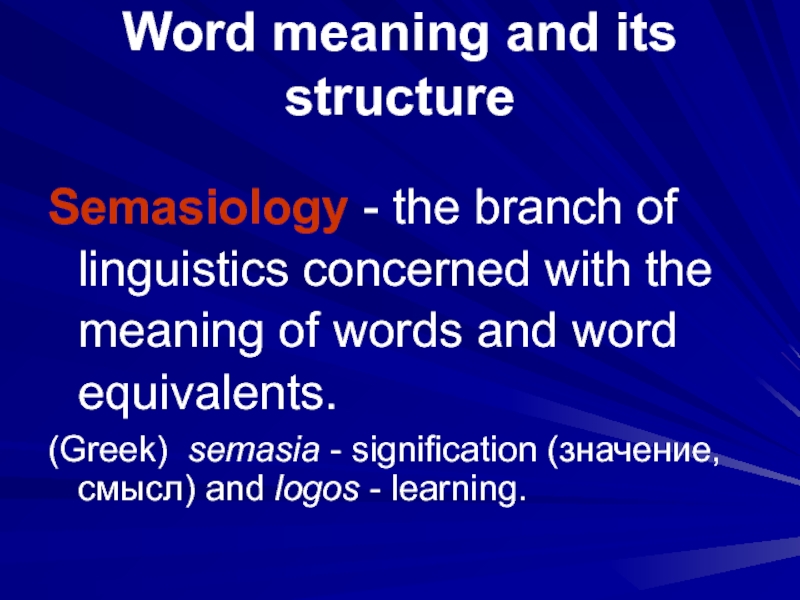
Слайд 2The main objects of semasiological study:
types of lexical meaning
polysemy
and semantic structure of words
semantic development of words
the main tendencies
of the change of word-meanings
semantic grouping in the vocabulary system (synonyms, antonyms)
semantic fields
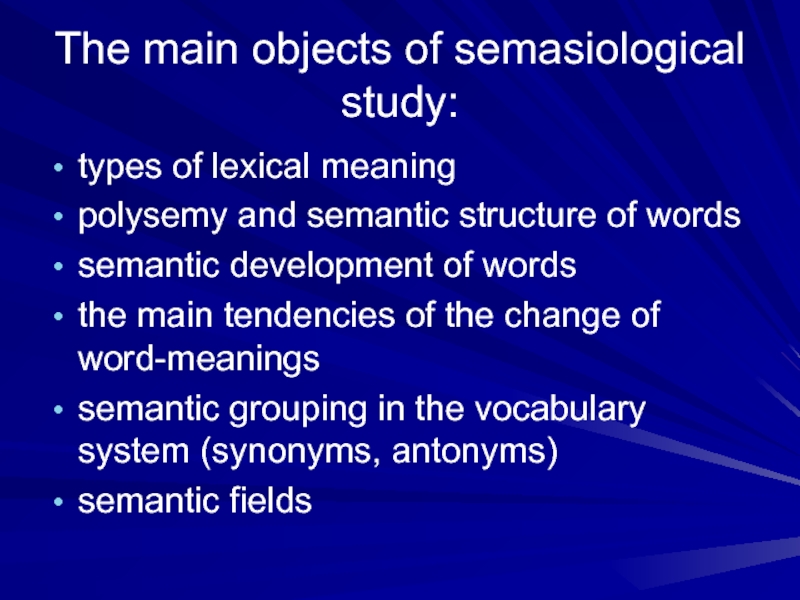
Слайд 3Approaches to Meaning
Referential approach
Functional approach
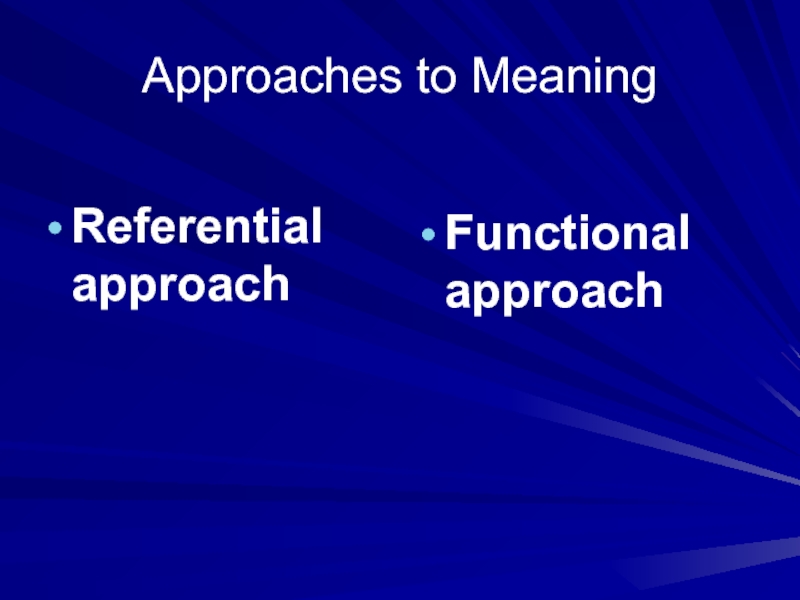
Слайд 4Referential approach to meaning
The meaning is in some form
or other connected with the referent (object of reality denoted
by the word).
The meaning is formulated by establishing the interdependence between words and objects of reality they denote.
The meaning is often understood as an object or phenomenon in the outside world that is referred to by a word.
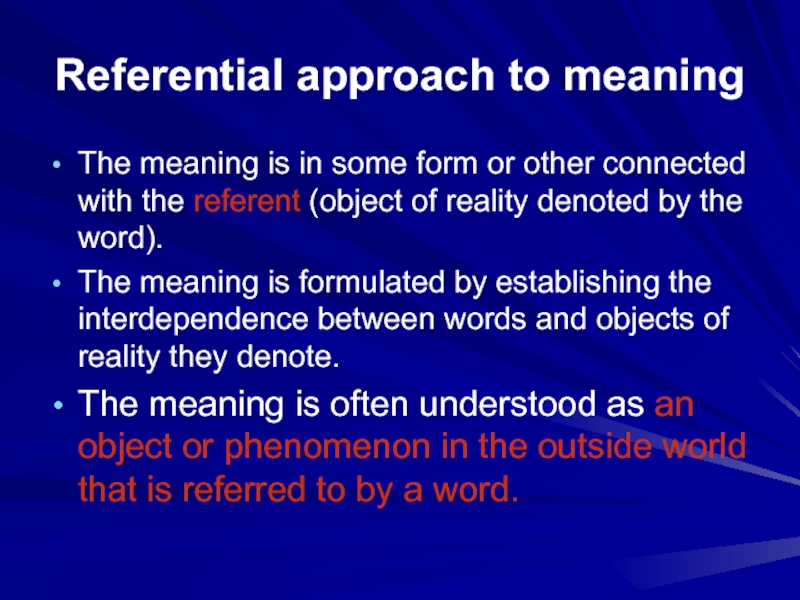
Слайд 5Functional approach to meaning
Words are studied in context; a
word is defined by its functioning within phrase or a
sentence.
The meaning of linguistic unit is studied only through its relation to other linguistic units.
The meaning is viewed as the function of a word in speech.

Слайд 6Concept
a category of human cognition (понятие, идея; общее представление; концепция).
the thought of the object that singles out the most
typical, the most essential features of the object.
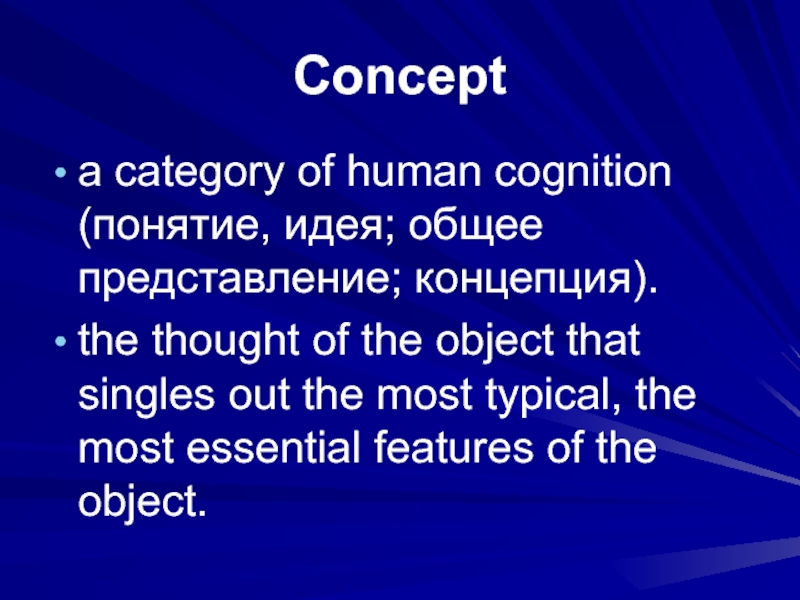
Слайд 7the concept of «a building for human habitation»
English
house
«fixed residence of family or household» −
home
Ukrainian
дім
домівкa
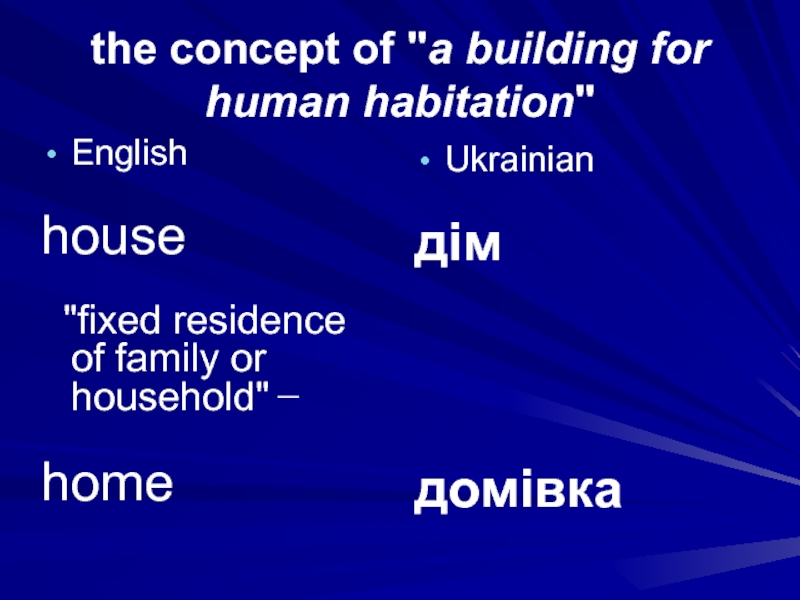
Слайд 8The difference between meaning and concept:
Concepts are always emotionally neutral
Meaning of many words not only conveys some reflection of
objective reality but also the speaker’s attitude to what he is speaking about, his state of mind.
The concept of size: big / large / tremendous
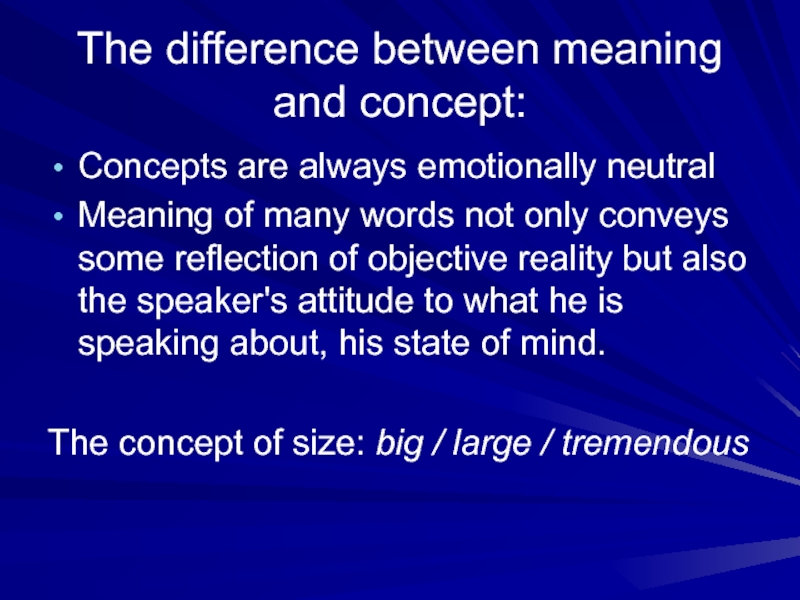
Слайд 9
(thought or reference)
Concept
Word ——————Referent
(symbol)
(object denoted
by the word)

Слайд 10The branch of linguistics which specializes in the study of
meaning is called semantics.
Meaning is a certain reflection in
our mind of objects, phenomena or relations that makes part of the linguistic sign − its so-called inner facet (аспект, грань, сторона), whereas the sound-form functions as its outer facet.
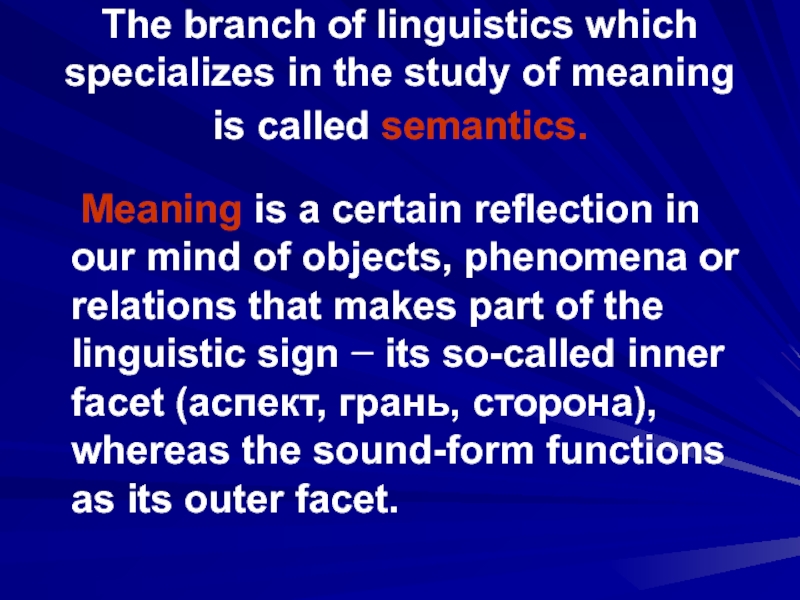
Слайд 11grammatical and lexical meanings
Grammatical meaning − the expression in speech
the relationships between words.
Lexical meaning − the realization of
concept or emotion by means of a definite language system.
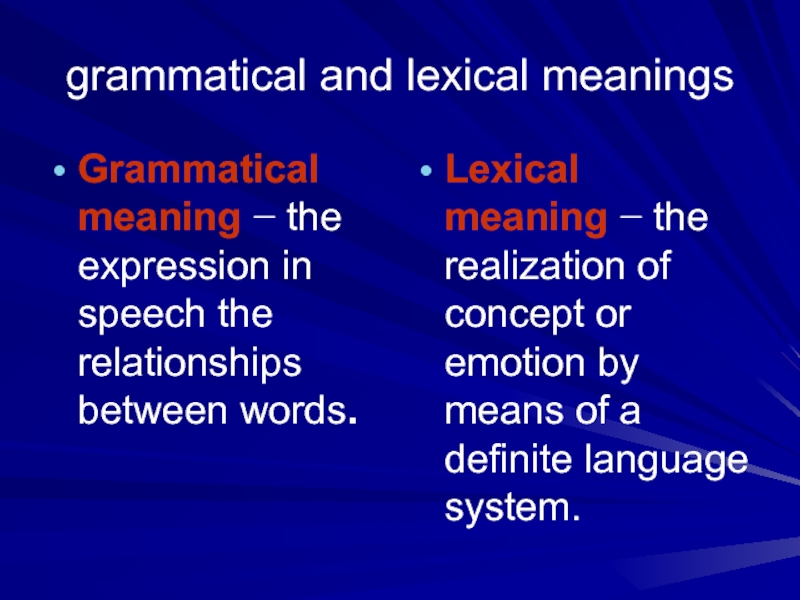
Слайд 12three types of lexical meaning of words:
1. Nominative
meaning determined by reality. The direct nominative meaning stands in
one-to-one relationship with a word. cat, table, sun
2. Phraseologically bound meaning of words depending on the peculiarities of their usage in a given language, e.g. to take care, to have a smoke, to catch a cold.
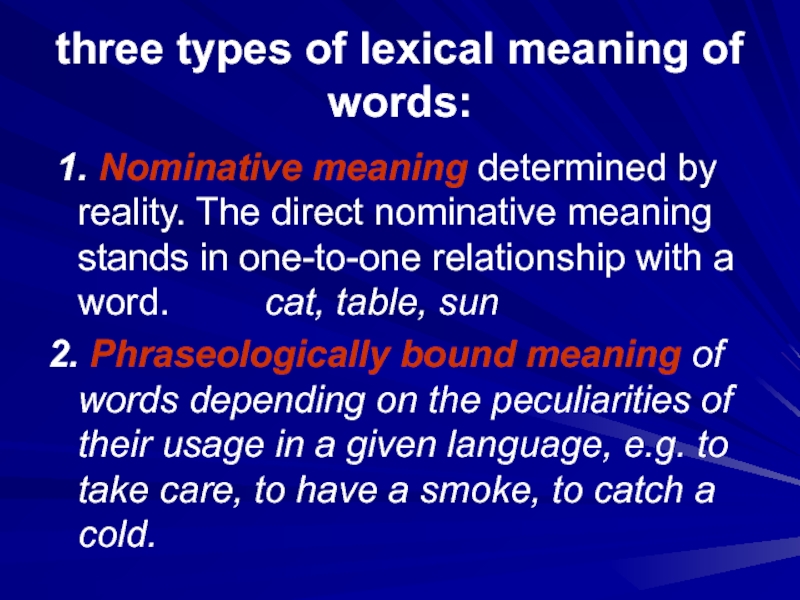
Слайд 13 3. Syntactically conditioned meanings
of words are
those which change with the change of the environment. Compare
the following verbs:
«to look» — to look for— to look after
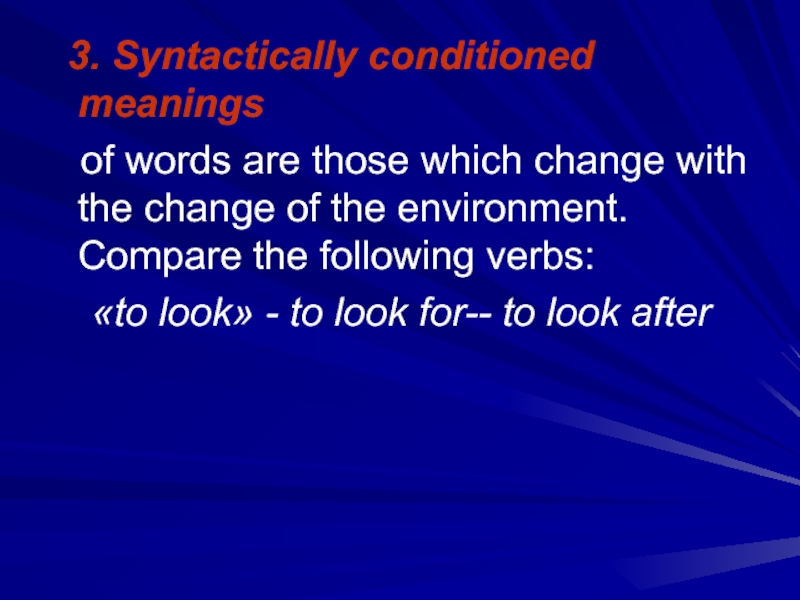
Слайд 14The structure of lexical meaning of a word
denotative
meaning
connotative meaning
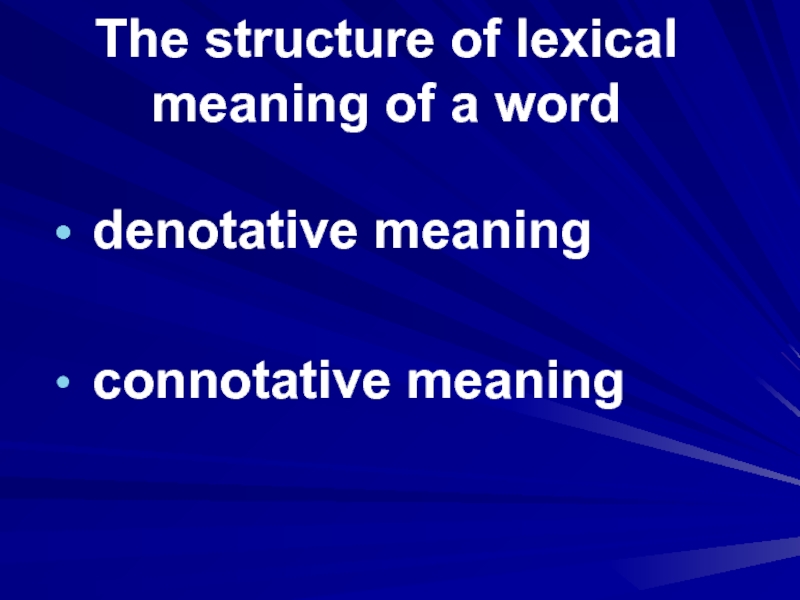
Слайд 15Denotative meaning
a linguistic expression for a concept or a
name for an individual object.
makes communication possible.
is bound up
with its referent.
may have one constant referent – a moon
may have several referents — a hand
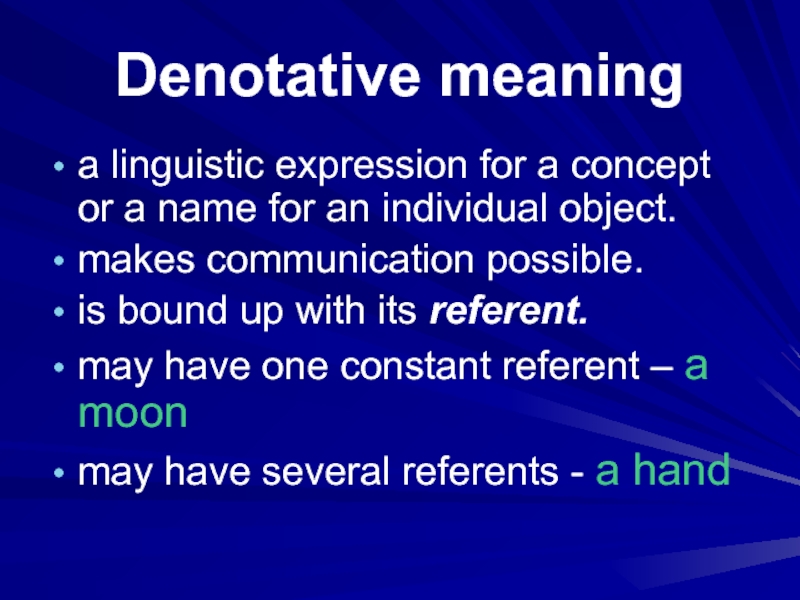
Слайд 16Connotative meaning
additional non-literal meaning of a word.
contains various shades
of meaning called connotations.
connotations reflect subjective, emotional attitude of
people toward object or phenomenon.
is unstable. In most cases it reveals itself only through contexts.
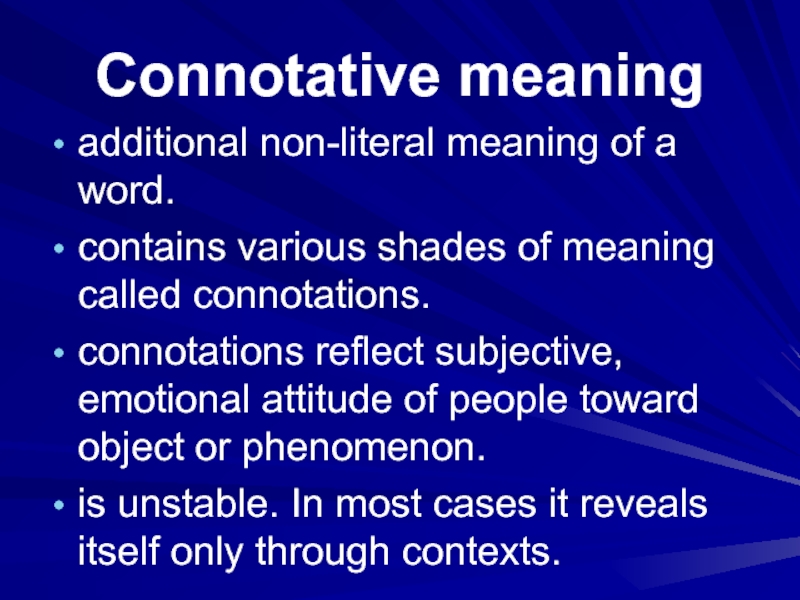
Слайд 17four main types of connotations:
stylistic connotation is what the word
conveys about the speaker’s attitude to the social circumstances and
the appropriate functional style (slay vs kill)
emotional connotation conveys the speaker’s emotions (mummy vs mother)
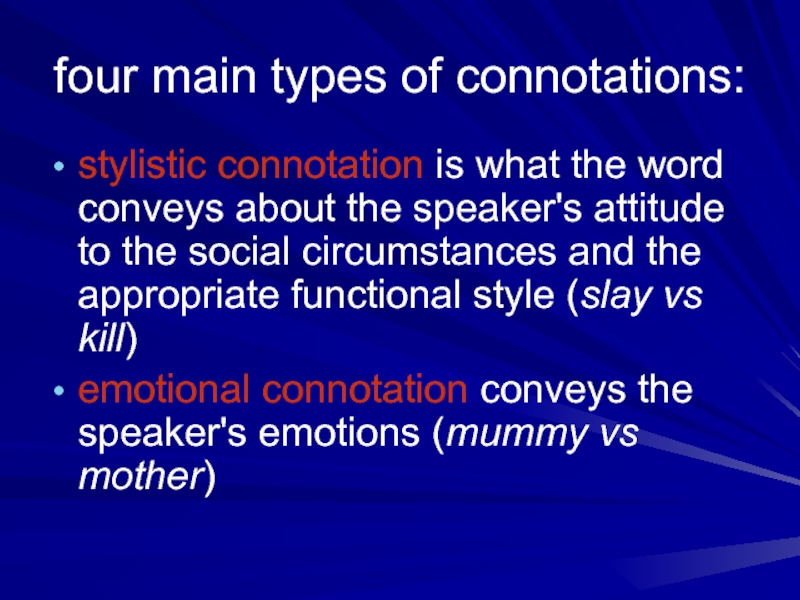
Слайд 18evaluative connotation may show his approval or disapproval of the
object spoken of (clique vs group)
expressive/intensifying connotation is conveyed
by degree of intensity (adore vs love)
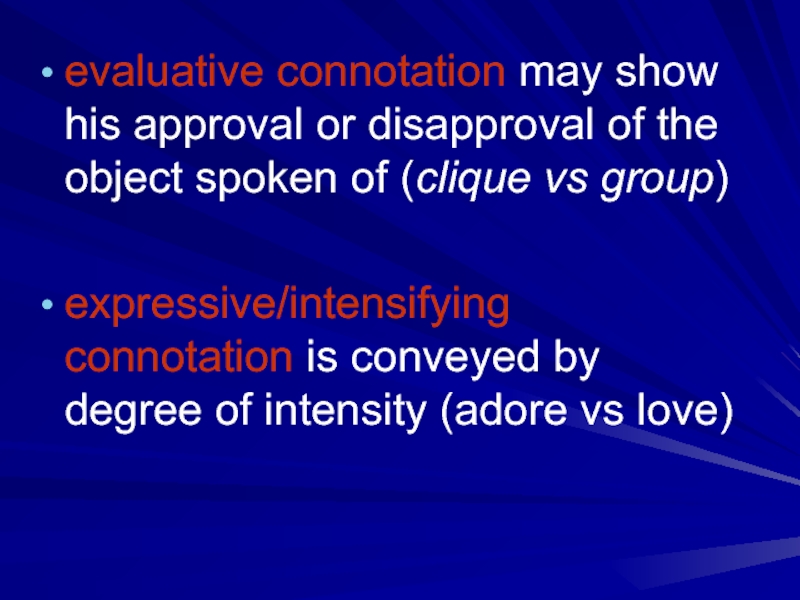
Слайд 19terrific
the denotative component of the lexical meaning of the
word is «frightening“.
the expressive or intensifying connotation is
«very, very good» or «very great»:
terrific beauty, terrific pleasure
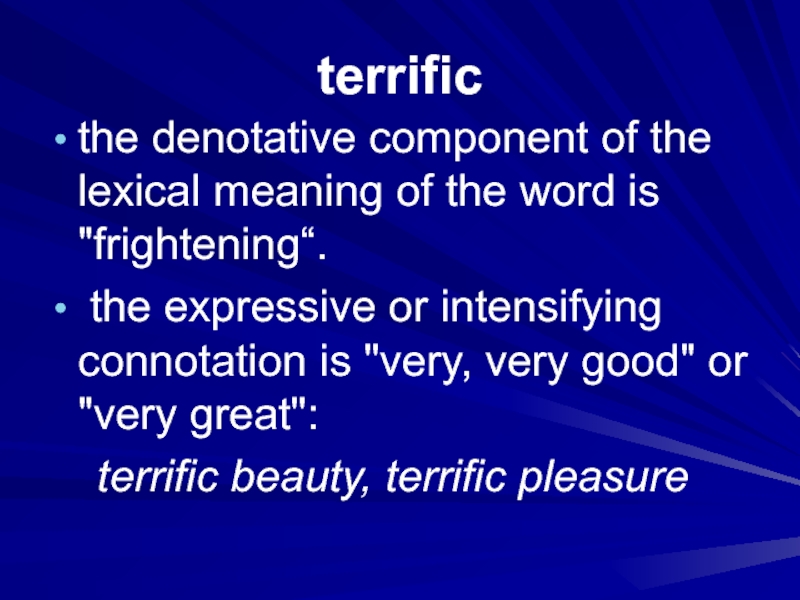
Слайд 20 It is the connotative meaning in a word which
helps create irony, sarcasm, metaphor and other figures of speech.

Слайд 21POLYSEMY
the ability of words to have more than one meaning.
A word having several meanings is called polysemantic and
most English words are like this.
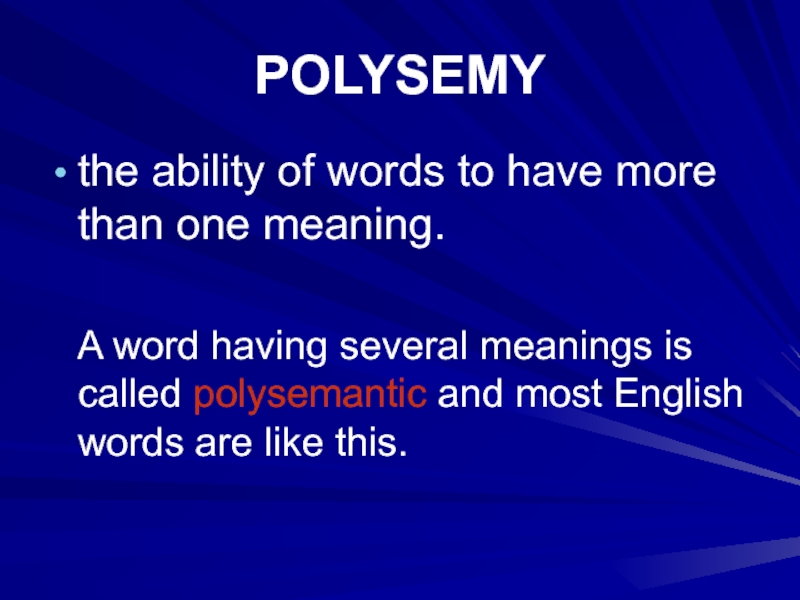
Слайд 22table
1) a flat horizontal slab or board, usually supported by
one or more legs, on which objects may be placed
2)
a) such a slab or board on which food is served we were six at table b) (as modifier) table linen c) (in combination) a tablecloth
3) food as served in a particular household or restaurant
4) such a piece of furniture specially designed for any of various purposes
5) a) a company of persons assembled for a meal, game, etc b) (as modifier) table talk
6) any flat or level area, such as a plateau
7) a rectangular panel set below or above the face of a wall

9) an upper horizontal facet of a cut gem
10) music the sounding board of a violin, guitar, or similar stringed instrument
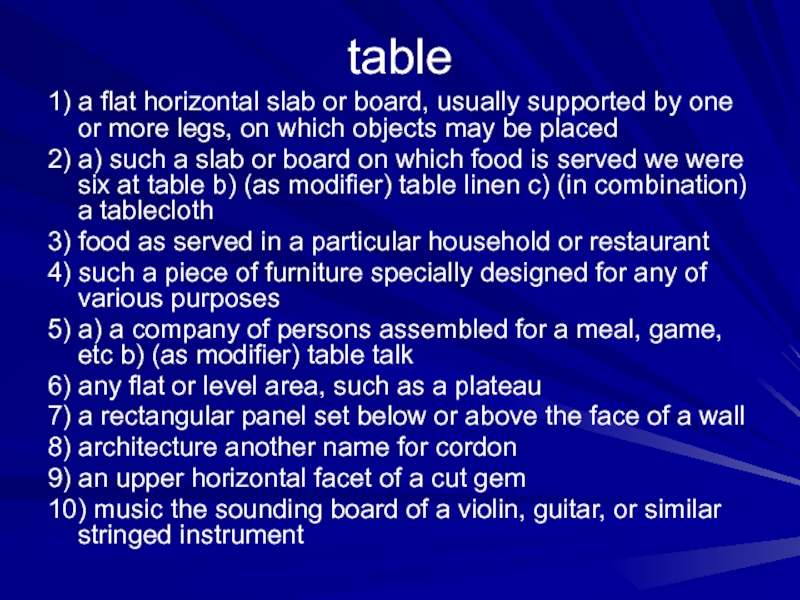
Слайд 23Change of lexical meaning in words
linguistic
— the influence of
linguistic environment
— analogy
— the context
extra-linguistic
— cultural
— social
—
psychological
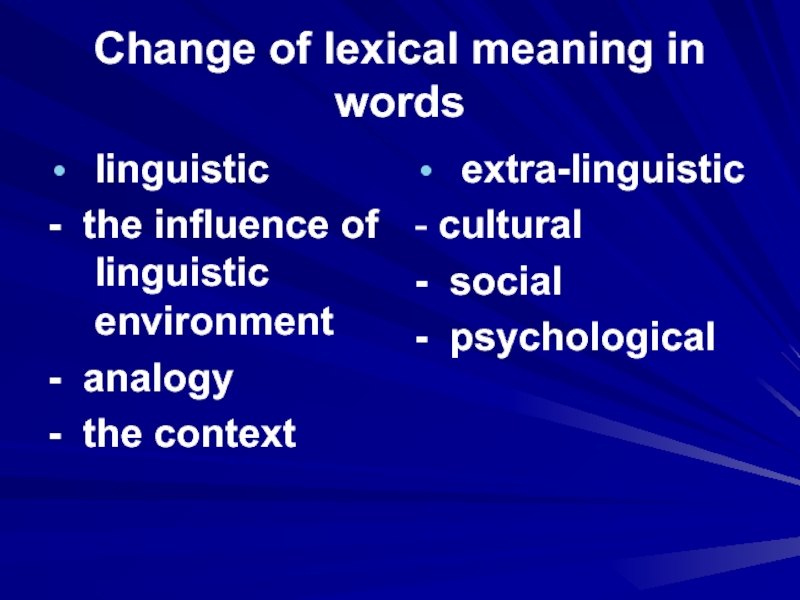
Слайд 24ways of change of word-meaning:
1. extension of meaning (generalization);
2. narrowing
of meaning (specialization);
3. transference of meaning (metaphor and metonymy);
4. elevation
of meaning (amelioration);
5. degradation of meaning (pejoration).

Слайд 251. Extension /expanding of meaning (or generalization).
In the
process of extension a word-meaning may acquire a higher degree
of abstraction or more generalized character.
“manuscript” originally meant only something handwritten. Now it refers to any copy either written by hand or printed.
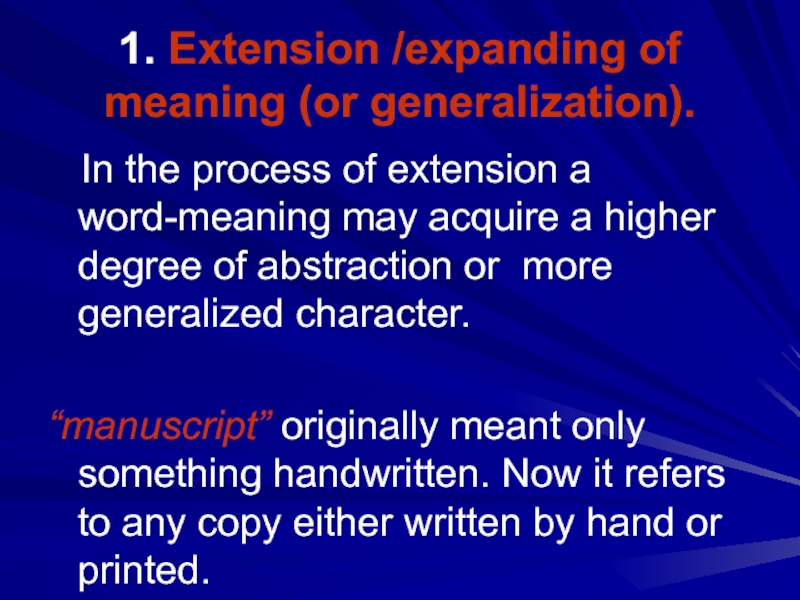
Слайд 262. Narrowing of meaning/contraction, (specialization).
In the process of
narrowing, a word-meaning acquires a specialized sense in which it
is applicable only to some of the objects or phenomena it previously denoted.
a corpse — a human or animal body, living or dead. Now this word has been specialized to mean «a dead body», usually that of a human being.
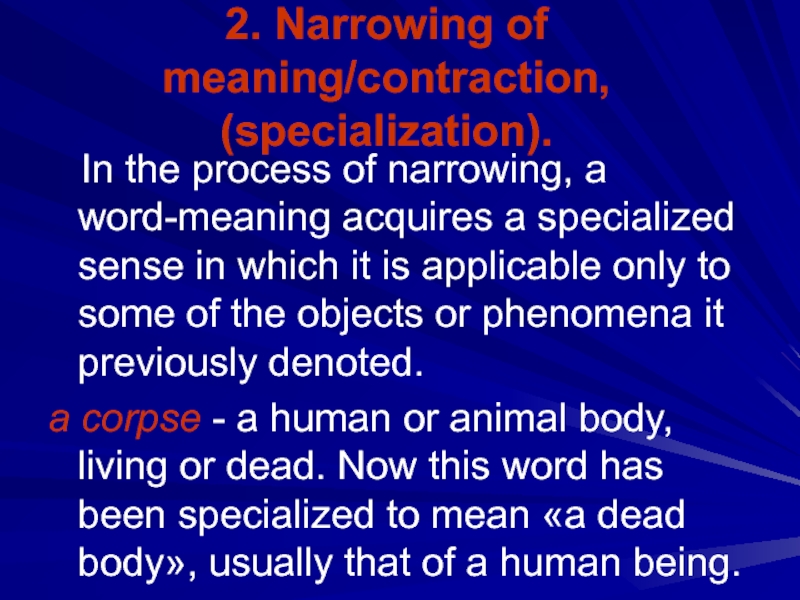
Слайд 273. Elevation of meaning (amelioration )
In the
process of elevation a word acquires the meaning of a
greater importance than its original meaning.
marshal — originally meant a horse servant, now its meaning is «an officer of the highest rank»
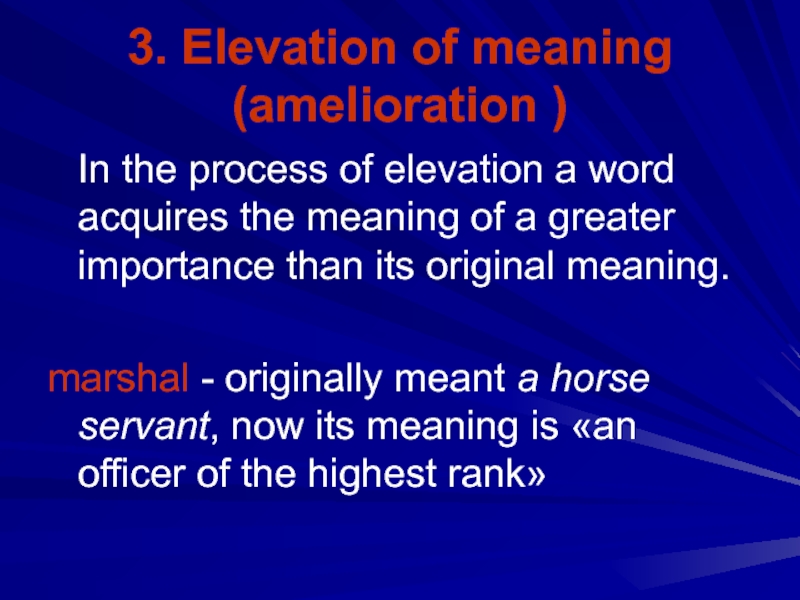
Слайд 284. Degradation of Meaning (degeneration, pejoration).
In the
process of pejoration the word acquires unfavourable connotations or falls
into disrepute.
«vulgar» — originally meant «common, ordinary»;
«gossip» — originally meant «a god parent»;
«silly» — originally meant «happy».
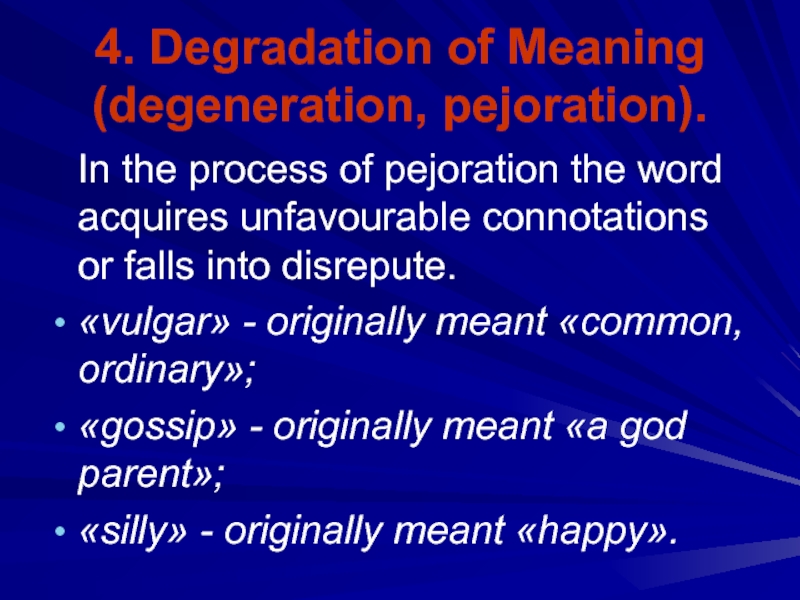
Слайд 295. Transference of meaning.
Transference of meaning takes place when
the figures of speech are used.
Figures
of speech are expressive means and stylistic devices such as metaphor and metonymy.

Слайд 30Metaphor
the transference of the literal meaning in a
word based on the association of similarity between the objects
or phenomena.
a woman can be called «a peach» if she is young and beautiful, or «a lemon» if she is ugly and boring.
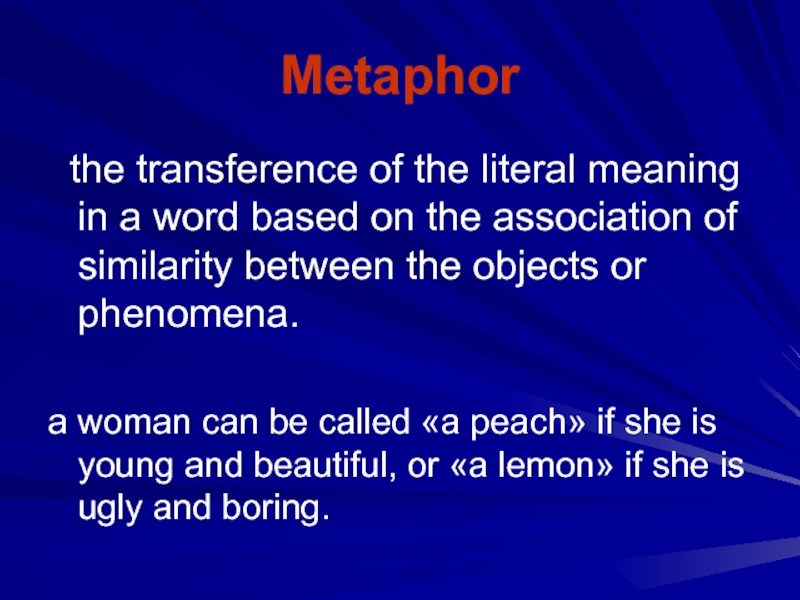
Слайд 31Metonymy
the transference of the literal meaning of a
word based on the association of contiguity between objects or
phenomena.
«cash» is an adaptation of the French word «caisse» which means «box» and in which money was contained. Now the meaning of this word is «money».
«crown» in the meaning of «monarchy»
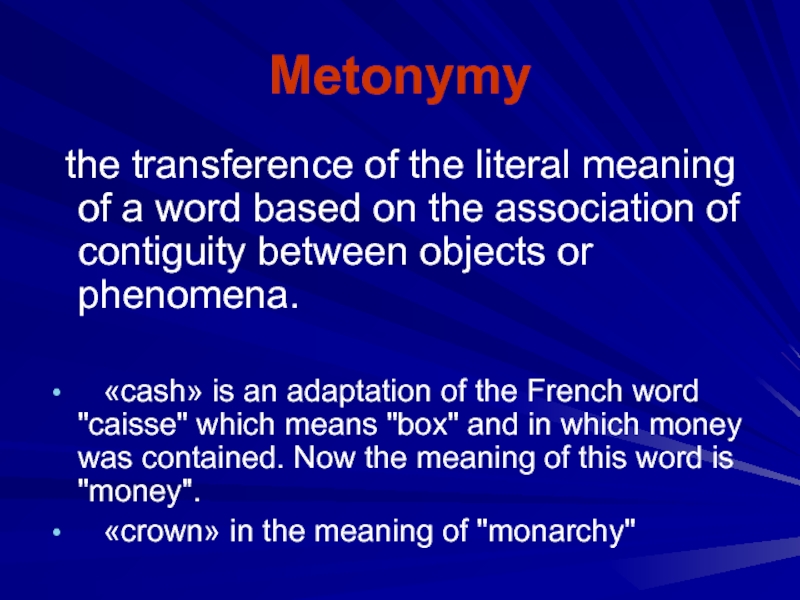
17. Types of meaning. Semantic structure
of the word.
Types of meaning
Типы значений
There are two main types of meaning:
1) the grammatical meaning,
2. the lexical meaning.
Есть два основных типа значения:
1) грамматический смысл,
2. лексический смысл.
1. The grammatical meaning is the formal meaning of a word. It is
defined as the meaning belonging to the lexico-grammatical classes and
grammatical categories. It is expressed by the word’s form. Every word
belongs to a definite part of speech and every part of speech has a certain
grammatical categories. E.g. verbs have tense, voice, mood, person etc. Nouns
have the categories of case, number etc. E.g. the words “asked”, “thought”,
“talked”, “took, ran” have the grammatical meaning of tense. The grammatical
meaning unites words into big groups such as parts of speech.
1.Грамматический смысл — это формальный смысл слова.
Он определяется как значение, относящееся к лексико-грамматическим классам и
грамматическим категориям. Это выражается формой слова. Каждое слово
принадлежит определенной части речи, и каждая часть речи имеет определенные
грамматические категории. Ex. Глаголы имеют напряженный,
голос, настроение, лицо и т. Д. Существительные имеют категории случаев,
число и т. Д. Пример. Слова «спросили», «подумали», «поговорили», «взяли,
побежали», имеют грамматический смысл времени. Грамматический смысл
объединяет слова в большие группы, такие как части речи
2. The lexical meaning is the material meaning of a word. This is
a meaning which gives the concept of a word. By the lexical meaning the word
expresses the basic properties of the thing the word denotes.
2.Лексический смысл — это
материальный смысл слова. Это значение, которое дает понятие слова. По
лексическому значению слово выражает основные свойства вещи, которую
обозначает слово.
The lexical meaning of a word falls into two:
1) the denotational meaning,
2) the connotational meaning.
Denotational meaning makes communication
possible because words denote things, concepts, they name them.
E.g. the denotational meaning of the word
“table” is a piece of furniture consisting of a flat top with four supports
(called legs).
The denotational meaning is associated with
emotions (e.g. He besought a favour of the judge: Here the word “beseech”
means “to ask eagerly and also anxiously”). Evaluative connotation denotes
approval or disapproval relations to the thing or phenomena,
E.g. colt, a young male horse used for a young
inexperienced person; pup- a young dog used for a person. These words have
negative evaluation.
But in English we have words which have positive
evaluation (ex. bunny — кролик, bunting-лапочка).
Intensifying connotation is the reinforcement of
the sign: it indicates the special importance of the thing expressed. E.g.
awfully glad, terribly important.
Лексический смысл слова делится на два:
1) денотационный смысл,
2) коннотационный смысл.
Денотационный смысл делает общение
возможным, потому что слова обозначают вещи, понятия, они называют их.
Ex. Денотационный смысл слова «стол» —
это предмет мебели, состоящий из плоской вершины с четырьмя опорами
(называемых ногами).
Денотационный смысл связан с эмоциями
(например, он просил о помощи судьи: здесь слово «умолять» означает «спросить
с нетерпением, а также с тревогой»). Оценочная коннотация означает одобрение
или неодобрение отношений с вещью или явлениями, например.
Colt — молодой мужской конь,
используемый для молодого неопытного человека; Pup — молодая собака,
используемая для человека. Эти слова имеют отрицательную оценку.
Но на английском языке мы имеем слова,
которые имеют положительную оценку (например, кролик — кролик,
bunting-лапочка.
Усиление связи — это усиление знака: оно
указывает на особую важность выраженной вещи. Ex. Ужасно рад, ужасно важно
The connotational meaning is
a meaning which has a stylistic shade. It serves to express all sorts of
emotions, expressiveness. Connotation may be shortly defined as emotional and
evaluative component of the lexical meaning, Comparing the meanings of
English words “well-known”, “famous”, “notorious” we see that all these words
express the denotational meaning “widely known”. But the word “famous” has a
positive evaluative meaning and “notorious has a negative evaluation. So, the
words “well-known”, “famous”, “notorious” differ in their emotional colouring
and evaluation.
The connotational meaning may be expressed also
either in the emotive charge or in stylistic reference.
E.g. “aunt” and “auntie”. These words have the
same denotational meaning but the word “aunt” has no emotive charge but
“auntie” has it.
Коннотационный смысл — это значение,
имеющее стилистический оттенок. Он служит для выражения всех видов эмоций,
выразительности. Коннотация может быть коротко определена как эмоциональная и
оценочная составляющая лексического значения. Сравнивая значения английских
слов «хорошо известные», «знаменитые», «печально известные», мы видим, что
все эти слова выражают денотационное значение «широко известно». Но слово
«знаменитый» имеет положительный оценочный смысл, а «печально известная»
отрицательная оценка. Итак, слова «хорошо известны», «знаменитые», «печально
известные» отличаются своей эмоциональной окраской и оценкой.
Коннотационный смысл может быть выражен либо в
эмоциональном заряде, либо в стилистической ссылке.
Ex. «Тетя» и «тетушка». Эти слова имеют
одинаковый денотационный смысл, но слово «тетя» не имеет эмоционального
заряда, но «тетушка» имеет его.
Stylistically words can be subdivided into literary,
neutral and colloquial
layers.
Neutral words are words of
general use. E.g. the words “to begin” (начинать) and “to commence”(начинать) “dad”
and “ father” have the same denotational meanings but “to begin” and “father”
are stylistically neutral words, whereas “dad” is a colloquial word and “ to
commence” stylistically is a literary word.
Стилистически
слова можно подразделить на
литературные,
нейтральные и
разговорные слои.
Нейтральные слова —
это слова общего пользования. Ex. Слова «начать» (начинать) и «начать»
(начинать) «папа» и «отец» имеют одинаковые денотационные значения, но
«начать» и «отец» являются стилистически нейтральными словами, тогда как
«папа» — это разговорный Слово и «начать» стилистически — это литературное
слово.
Besides the lexical and grammatical meanings we
can observe
differential,
functional and
distributional meanings of a word.
Differential meaning is the semantic component
that serves to distinguish one word from other in words containing the same (identical)
morphemes.
E.g. “note-book”. The morpheme “note” serves to
distinguish the word from other words: exercise-book, copy-book or:
bookshelf, bookcase.
The functional meaning may be seen in derivational
morphemes. If we see words with the suffixes -ment, -er, -ity, -or, we say
that they are nouns.
E.g. establishment, plurality, teacher,
translator, sailor.
If -ful, -less, -able, -al etc. are present in
words we say adjectives.
E.g. helpful, handless, guiltless, readable,
national, writable, operational, openable, proposal.
The distributional meaning is found in all words
having more than one morpheme. It is found in the arrangement and order of
morphemes making up the word.
E.g. “teacher” but not *erteach.
“boyishness”
but not *nessboyish.
Помимо лексических и грамматических
значений, мы можем наблюдать
дифференциальные,
функциональные и
распределительные значения слова.
Дифференциальное значение — это
семантическая составляющая, которая служит для того, чтобы отличить одно
слово от другого в словах, содержащих одни и те же (зубные) морфемы.
Ex. «блокнот». Морфема
«примечание» служит для того, чтобы отличить слово от
Другими словами: тетрадь, тетрадь или
книжная полка, книжный шкаф.
Функциональное значение можно увидеть в
деривационных морфемах. Если мы видим слова с суффиксом, -er, -ity, -или, мы
говорим, что они существительные.
Например. Создание, множественность,
учитель, переводчик, матрос.
If -ful, -less, -able, -al и т. Д.
Присутствуют в словах, мы говорим прилагательные.
Ex. Полезный, бесшумный, невинный,
читаемый, национальный, доступный для записи, операционный, открываемый,
предложение.
Значение распределения содержится во
всех словах, имеющих более одной морфемы. Он находится в расположении и
порядке морфем, составляющих слово.
Ex. «Учитель», но не * erteach.
«Боязливость», но не
* nessboyish.
Different types of the lexical meaning of one and the same word
are considered its lexico-semantic variants. Lexico-semantic variants in
their correlations and interconnection form the semantic structure of the
word. In the semantic structure of the word there is special information on
the members and the conditions of communication. The intercourse and personal
contacts in real situations may reveal the pragmatic aspect of the lexical
meaning of the word.
E.g. “Hello” is used in unofficial situations giving a signal at
the same time to the friendly relations of the members of the communication.
Различные лексические значения одного и того же слова считаются
его лексико-семантическими вариантами. Лексико-семантические варианты в их
корреляциях и взаимосвязи образуют семантическую структуру слова. В
семантической структуре слова есть специальная информация о членах и условиях
общения. Взаимоотношения и личные контакты в реальных ситуациях могут выявить
прагматический аспект лексического значения слова.
Ex. «Hallo» используется в неофициальных ситуациях, давая сигнал
в то же время к дружеским отношениям членов сообщения.
Semantic
structure of the word.
The semantic structure of the word. Types of lexical meaning.
The branch of Linguistics which studies the meaning of different
linguistic units is called Semantics. The part of Lexicology which studies
the meaning and the development of meaning of words is called Semasiology.
There are different approaches to the problem of word meaning:
1) The referential, or denotational approach is characterised by
the thought that (тем что) the essence (суть) of meaning lies in the
interconnection and interdependence between: the word as the sound form, the
referent, and the concept. Here meaning is the realisation of the
concept/notion by means of a definite language system.
2) The functional, or contextual approach is characterised by
the idea that the meaning of a linguistic unit may be studied only through
its relation to other linguistic units. Thus, meaning is understood as the
function of linguistic signs, or their use in context.
Word meaning is represented by different types of meaning:
grammatical, lexical, lexico-grammatical.
Grammatical meaning is the component of word meaning, recurrent
in identical sets of individual forms of different words. It is expressed by:
word-form (such as books, girls, boys – the meaning of plurality;
looked, asked – tense meaning);
The position of the word in relation to other words (e.g. He
sings well, She dances badly – ‘sings’ and ‘dances’ are found in identical
positions between a pronoun and an adverb, their identical distribution
proves that they have identical gr.m.)
Lexico-grammatical meaning of the word is the common denominator
(знаменатель) to all the meanings of the words belonging to a certain
lexico-grammatical class or group of words.
Lexical meaning is the component of word meaning recurrent in
all the forms of the word. The word forms go, goes, went, gone, going have
different gr.m., but they have one and the same l.m. ‘the process of
movement’.
The main component of L.m. are: the denotational meaning of
words is the same for all the speakers. It is the realisation of the concept
by means of the given language.
Семантическая структура слова. Типы лексического значения.
Филиал Лингвистики, изучающий значение различных языковых
единиц, называется семантикой. Часть Лексикологии, которая изучает смысл и
развитие смысла слов, называется Семасиология.
Существуют различные подходы к проблеме смыслового значения:
1) ссылочный или денотационный подход характеризуется мыслью,
что (тем что) суть (суть) смысла заключается в взаимосвязи и
взаимозависимости между: словом как звуковой формой, Референт и концепция.
Здесь смысл заключается в реализации понятия / понятия с помощью определенной
языковой системы.
2) Функциональный или контекстуальный подход характеризуется
тем, что значение лингвистической единицы может изучаться только через ее
связь с другими лингвистическими единицами. Таким образом, смысл понимается
как функция лингвистических знаков или их использование в контексте.
Значение слова представлено различными типами значений:
грамматическим, лексическим, лексико-грамматическим.
Грамматический смысл — это компонент значения слова,
повторяющийся в идентичных наборах отдельных форм разных слов. Это
выражается:
Слово-форма (например, книги, девочки, мальчики — значение
плюрализма, взгляд, заданное значение);
Положение слова по отношению к другим словам (например, он поет хорошо,
она плохо танцует — «поющие» и «танцы» находятся в одинаковых положениях
между местоимением и наречием, их идентичное распределение доказывает, что
они имеют одинаковые грамм .)
Лексико-грамматический смысл слова является общим знаменателем
(знаменатель) ко всем значениям слов, относящихся к определенному
лексико-грамматическому классу или группе слов.
Лексическое значение — это компонент слова, повторяющийся во
всех формах слова. Слово «формы» уходит, уходит, уходит, уходит, уходит
разное gr.m., но у них одно и то же l.m. «Процесс движения».
Основной компонент L.m. находятся: Денотационный смысл слов для всех динамиков
одинаковый. Это реализация концепции с помощью данного языка
The pragmatic aspect is the part of the meaning, that conveys information
on the situation of communication: information on the ‘time and space’
relationship of the participants, information on the participants in the
given language community, information on the register of communication.
The connotational meaning conveys the speaker’s attitude toward
what he is speaking about. There are 4 main types of connotations: a) The
emotional connotation expresses human emotions and feelings (e.g. daddy,
father); b) The evaluative connotation expresses approval or disapproval (e.g.
agent and spy, planning and scheming=planning secretly); c) The intensifying
connotation adds emphasis (усиление) to
the meaning. (e.g. enormous, huge, tremendous=very large); d) The stylistic
connotation determines the functional speech style characteristic of the word
usage (dad-father-parent; colloquial-neutral-bookish).
Прагматический аспект Является частью смысла, которая передает
информацию о ситуации коммуникации: информацию о взаимоотношениях участников
«времени и пространства», информацию об участниках данного языкового
сообщества, информацию о реестре сообщений.
Коннотационный смысл передает отношение говорящего к тому, о чем
он говорит. Существует четыре основных типа коннотаций: а) эмоциональная
коннотация выражает человеческие эмоции и чувства (например, папа, отец); Б)
оценочная коннотация выражает утверждение или неодобрение (например, агент и
шпион, планирование и интриги = планирование тайно); В) Усиление коннотации
добавляет акцент (усиление) на смысл. (Например, огромные, огромные, огромные
= очень); D) Стилистическая коннотация определяет функциональный стиль речи,
характерный для использования слова (отец-отец-родитель,
разговорный-нейтральный-книжный).
Слайд 1Lecture 3
Semantic Structure of the Word and Its Changes
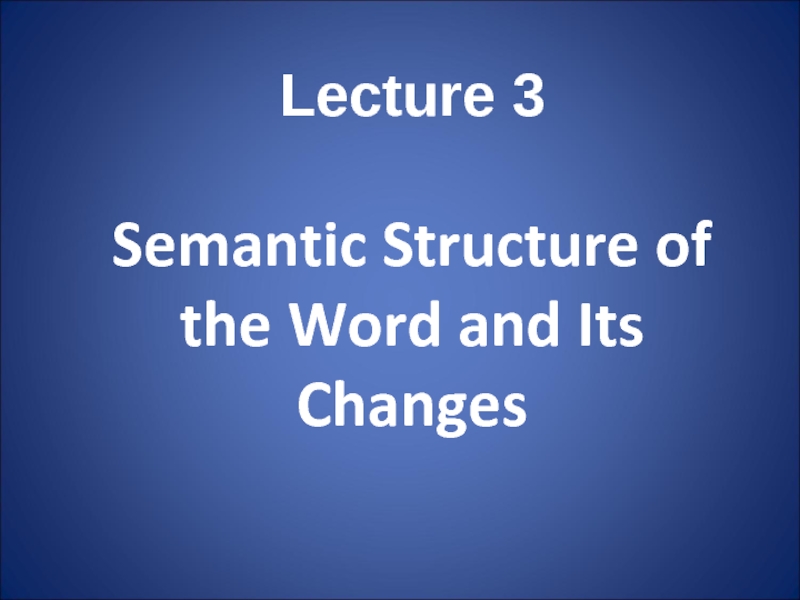
Слайд 2Plan:
Semantics / semasiology. Different approaches to word-meaning.
Types of word-meaning.
Polysemy. Semantic
structure of words. Meaning and context.
Change of word-meaning: the causes, nature and results.
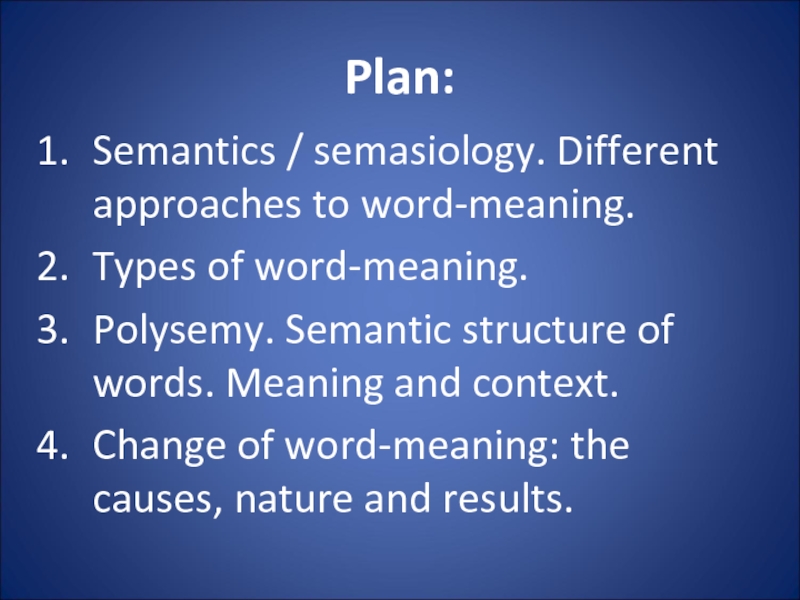
Слайд 3List of Terms:
semantics
referent
referential meaning
grammatical meaning
lexical meaning
denotational meaning
connotational meaning
polysemantic word
polysemy
lexical-semantic variants
basic meaning
peripheral
meaning
primary meaning
secondary meaning
radiation
concatenation
lexical context
grammatical context
thematic context
ellipsis
differentiation of synonyms
linguistic analogy
metaphor
metonymy
restriction of meaning
extension of meaning
ameliorative development of meaning
pejorative development of meaning
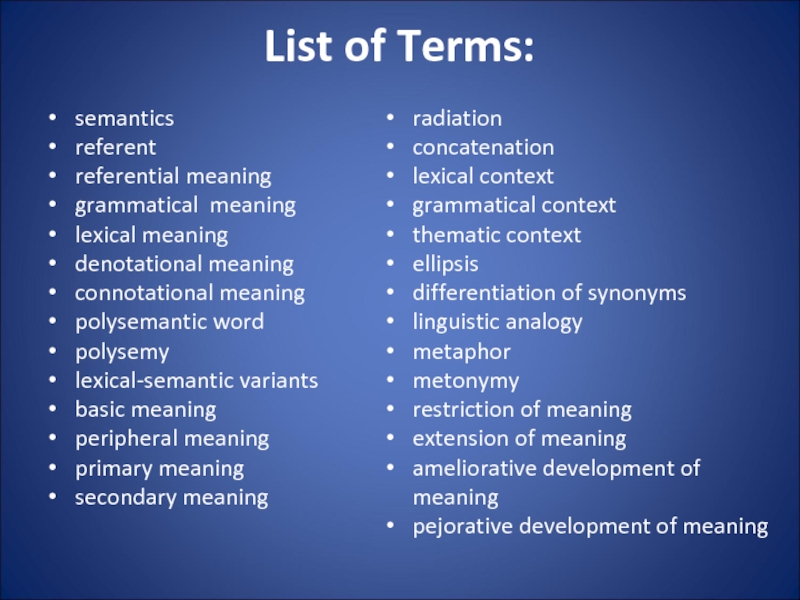
Слайд 4
It is meaning that makes language useful.
George A. Miller,
The science of word, 1991
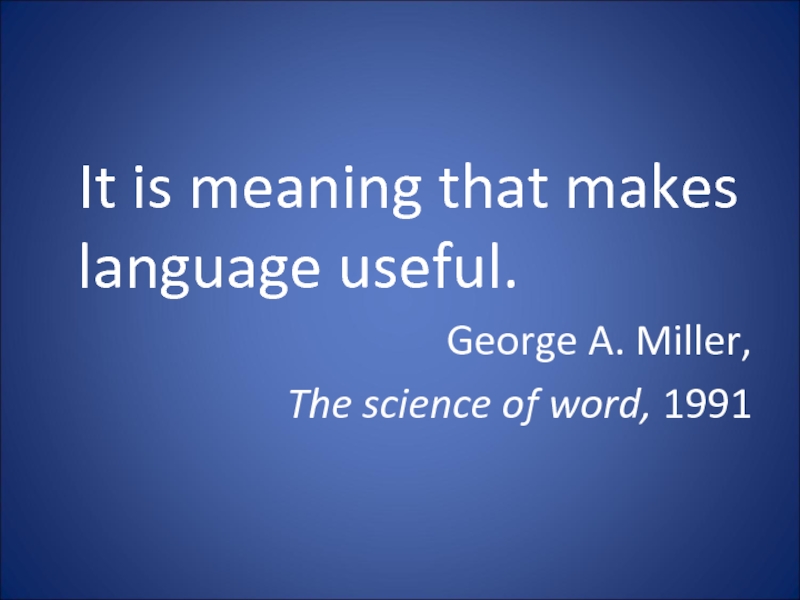
Слайд 5
1. Semantics / semasiology. Different approaches to word-meaning
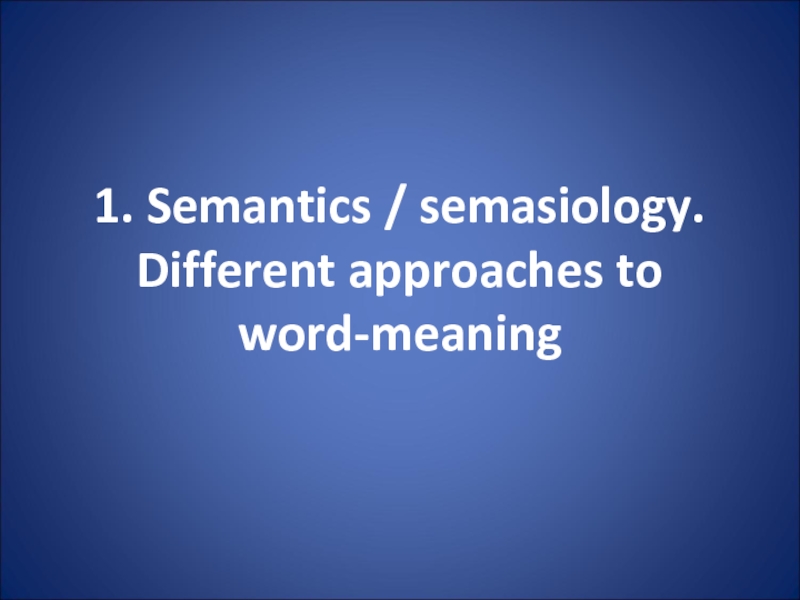
Слайд 6
The function of the word as a unit of
communication is possible by its possessing a meaning.
Among the word’s various characteristics meaning is the most important.
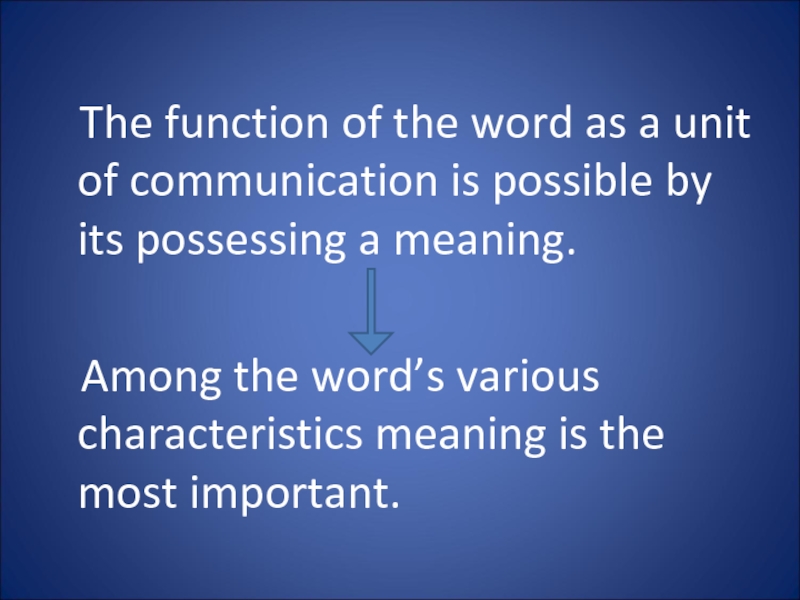
Слайд 7
«The Meaning of Meaning» (1923) by C.K. Ogden and I.A. Richards
– about 20 definitions of meaning
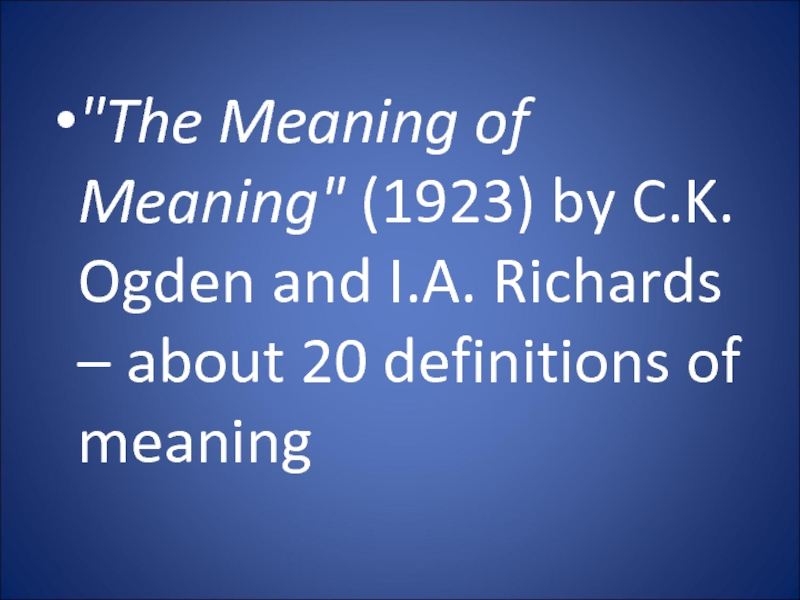
Слайд 8Meaning of a linguistic unit, or linguistic meaning, is studied by
semantics
(from Greek – semanticos ‘significant’)
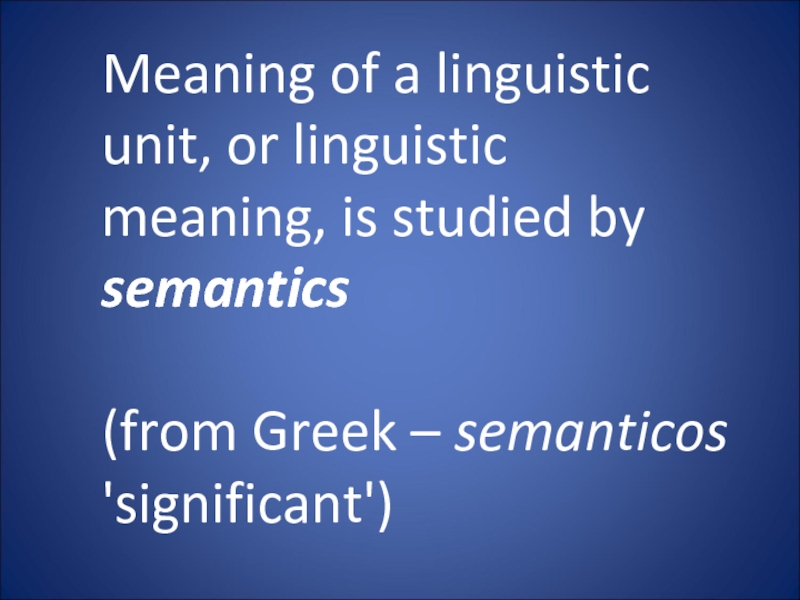
Слайд 9
This linguistic study was pointed out in 1897 by
M. Breal

Слайд 10
Semasiology is a synonym for ‘semantics’
(from
Gk. semasia ‘meaning’ + logos ‘learning’)
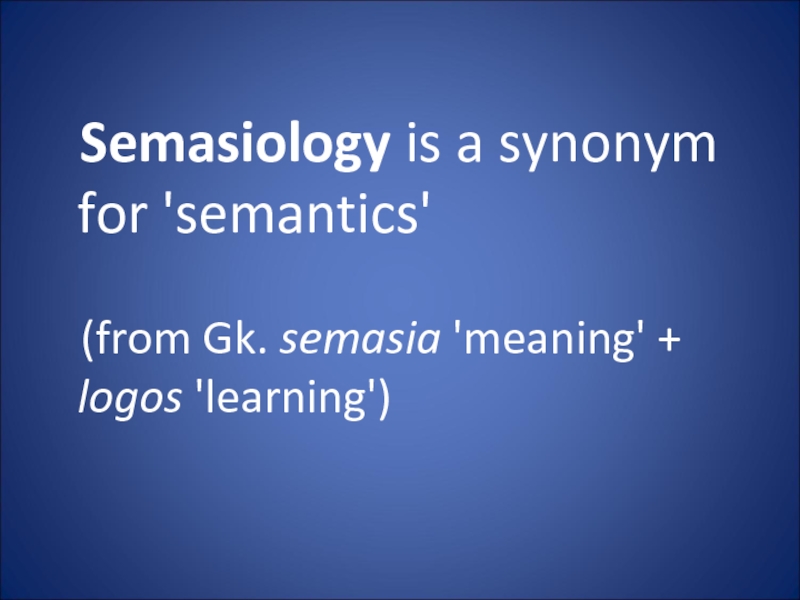
Слайд 11Different Approaches to Word Meaning:
ideational (or conceptual)
referential
functional
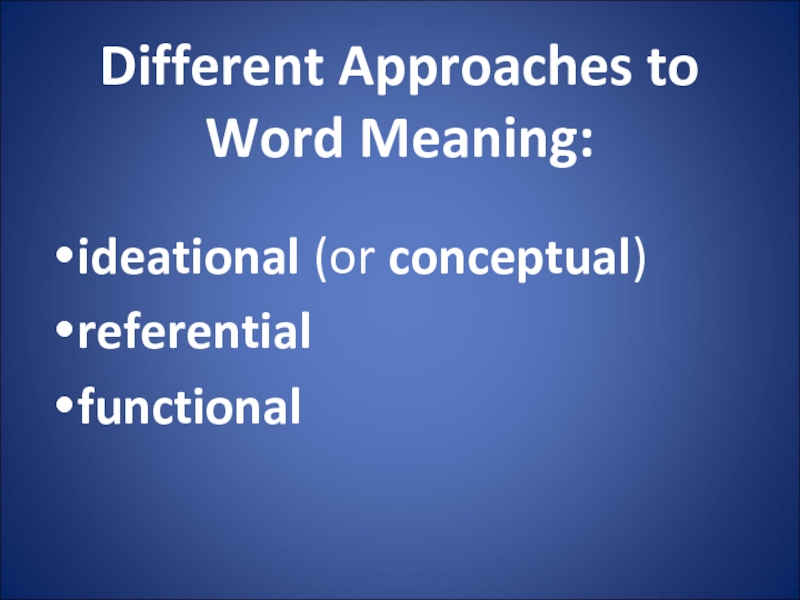
Слайд 12
The ideational theory can be considered the earliest theory
of meaning.
It states that meaning originates in the mind in the form of ideas, and words are just symbols of them.

Слайд 13A difficulty:
not clear why communication and understanding are possible if
linguistic expressions stand for individual personal ideas.

Слайд 14Meaning:
a concept with specific structure.
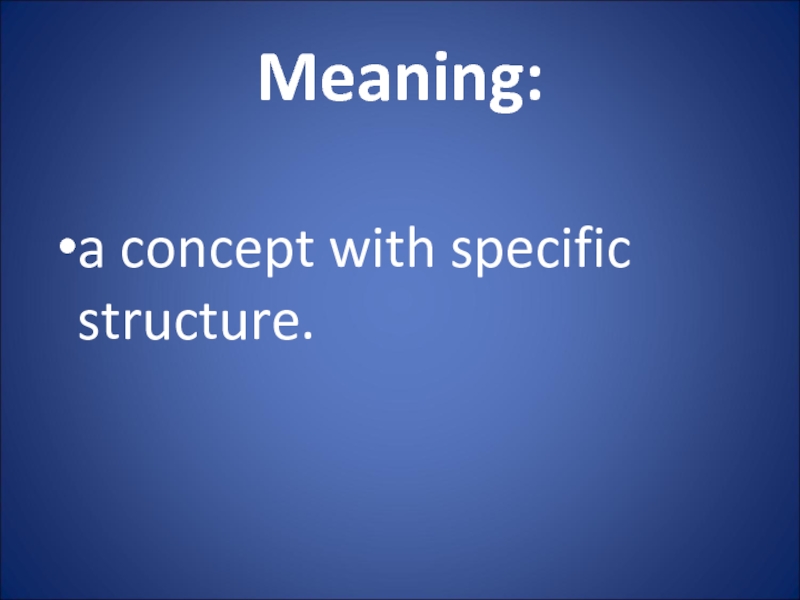
Слайд 15
Do people speaking different languages have different conceptual systems?
If people
speaking different languages have the same conceptual systems why are identical concepts expressed by correlative words having different lexical meanings?
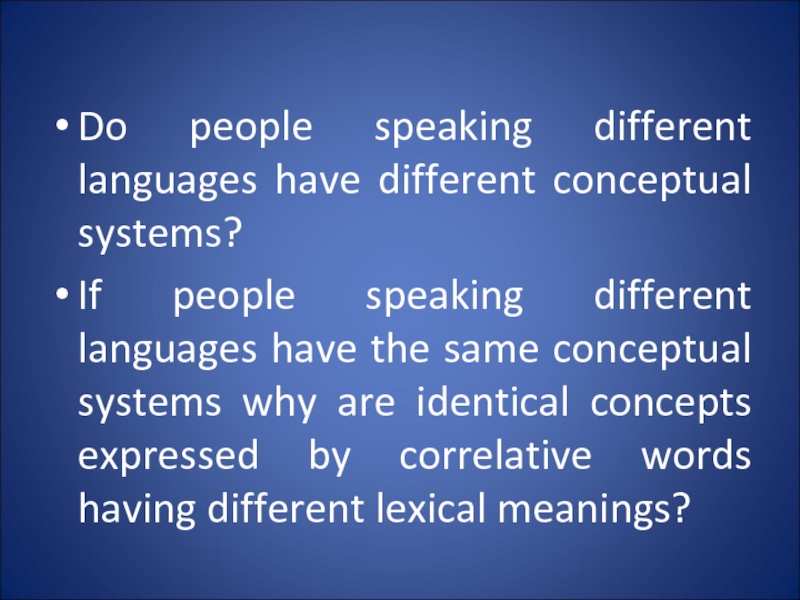
Слайд 16
finger ‘one of 10 movable parts of joints at the end
of each human hand, or one of 8 such parts as opposed to the thumbs‘
and
палец ‘подвижная конечная часть кисти руки, стопы ноги или лапы животного’
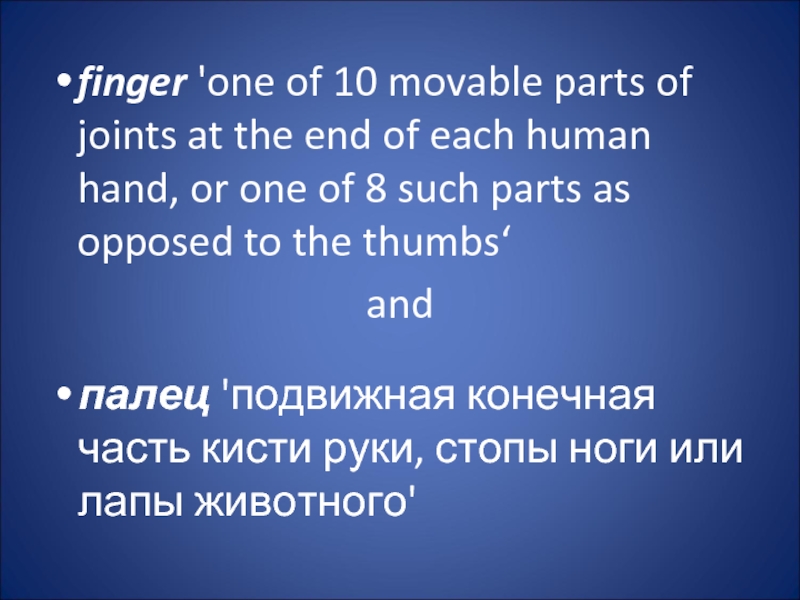
Слайд 17
Referential theory is based on interdependence of things,
their concepts and names.
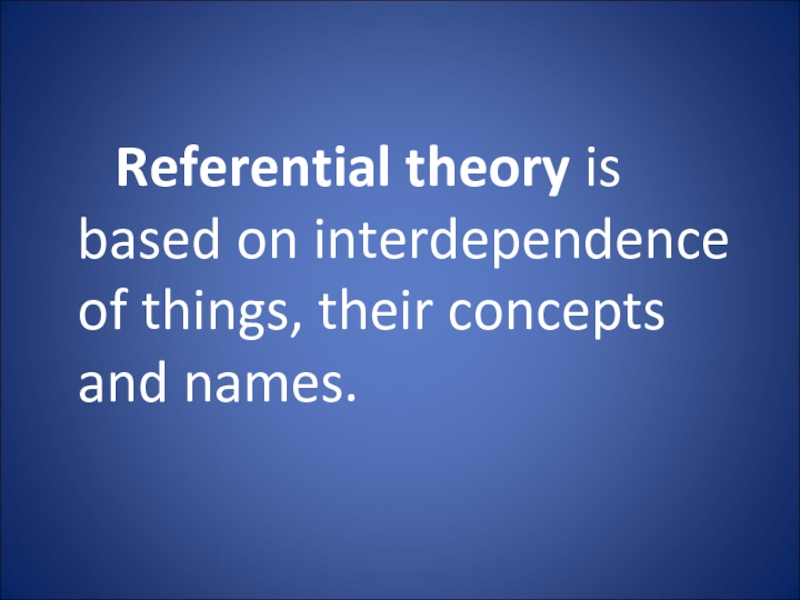
Слайд 18
The complex relationships between referent (object denoted by the
word), concept and word are traditionally represented by the following triangle:
Thought = concept
Symbol = word Referent = object
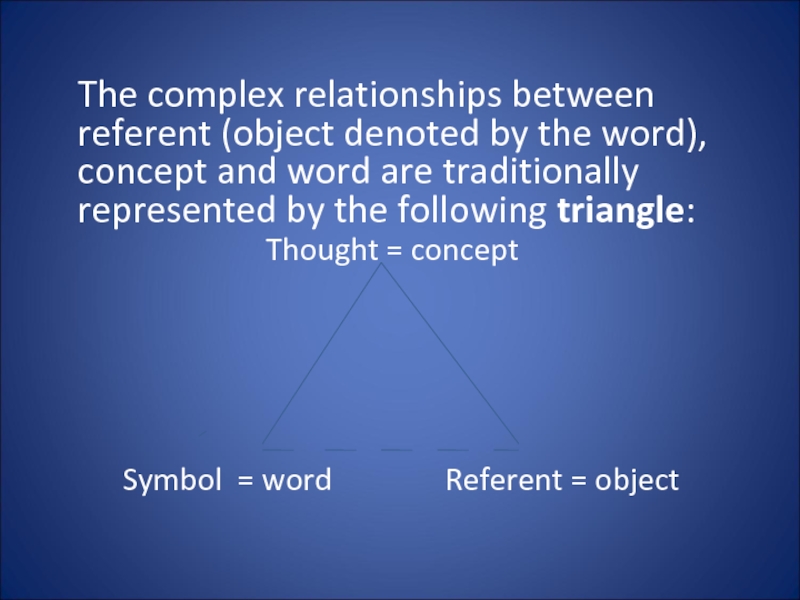
Слайд 19
an animal, with 4
legs and a tail, can bark and
bite
dog
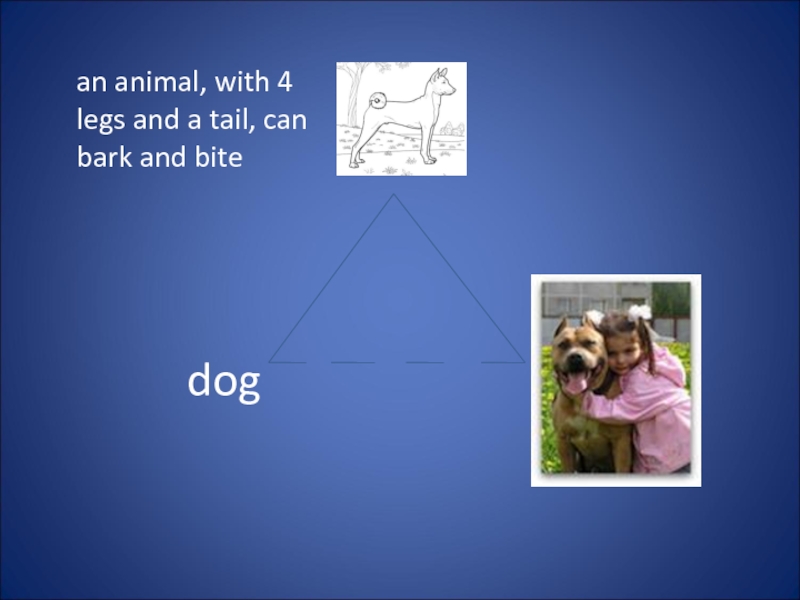
Слайд 20Meaning concept
different words having different meanings may be
used to express the same concept
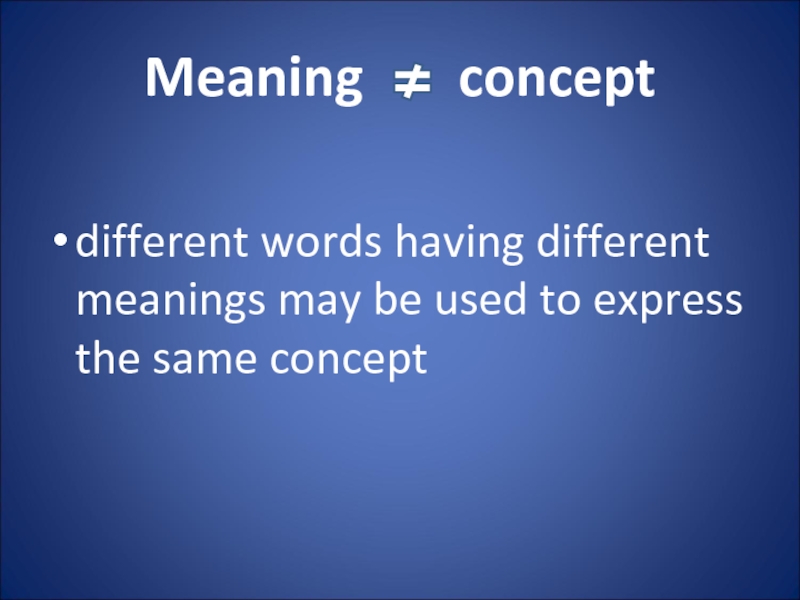
Слайд 21Concept of dying
die
pass away
kick the bucket
join the majority,
etc

Слайд 22Meaning symbol
In different languages:
a word with the same
meaning have different sound forms (dog, собака)
words with the same sound forms have different meaning (лук, look)
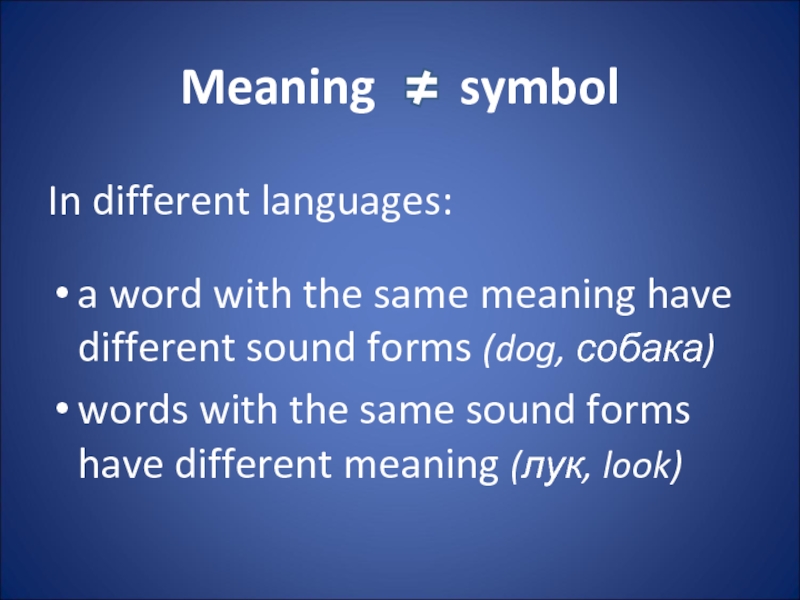
Слайд 23Meaning referent
to denote one and the same object
we can give it different names
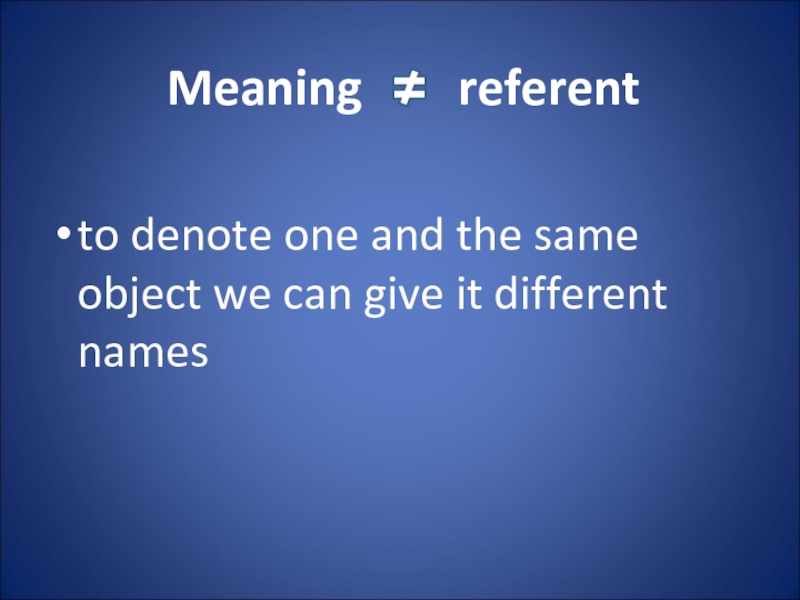
Слайд 24A horse
in various contexts:
horse,
animal,
creature,
it, etc.
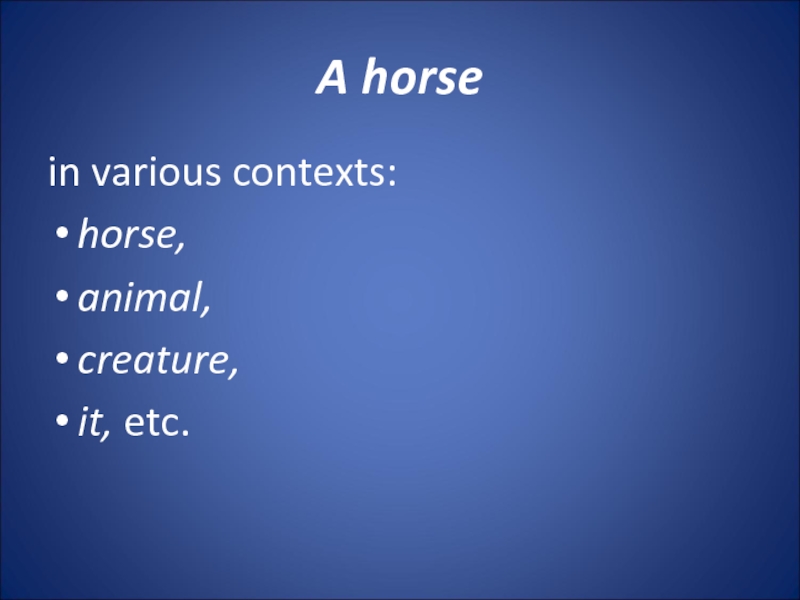
Слайд 25Word meaning:
the interrelation of all three components of
the semantic triangle: symbol, concept and referent, though meaning is not equivalent to any of them.
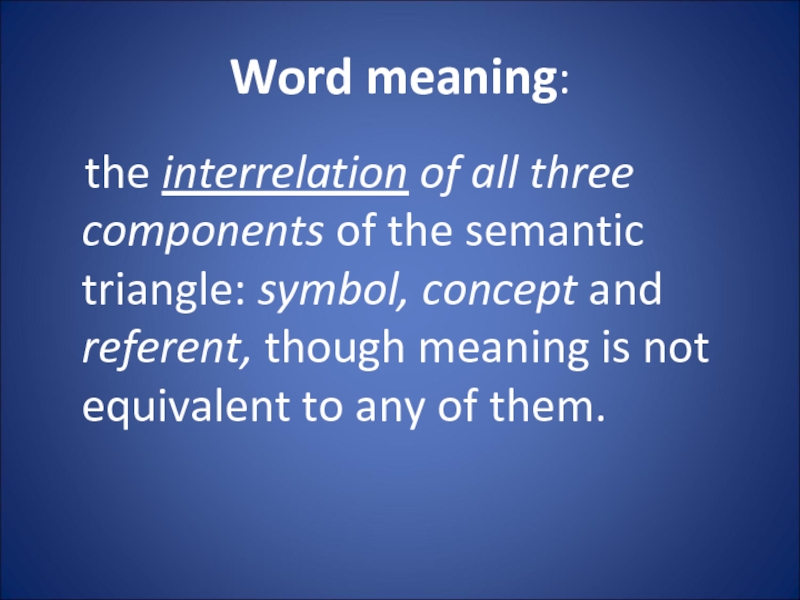
Слайд 26
Functionalists study word meaning by analysis of the way
the word is used in certain contexts.
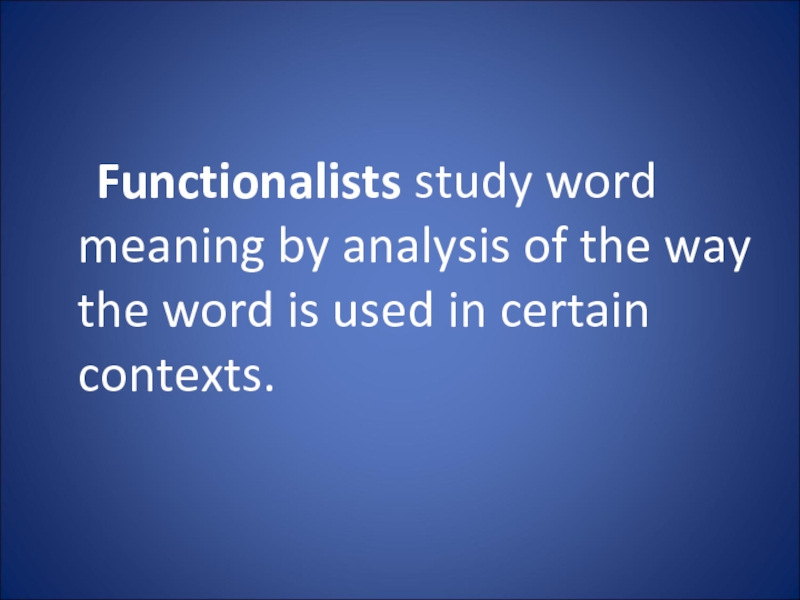
Слайд 27
The meaning of a word is its use
in language.
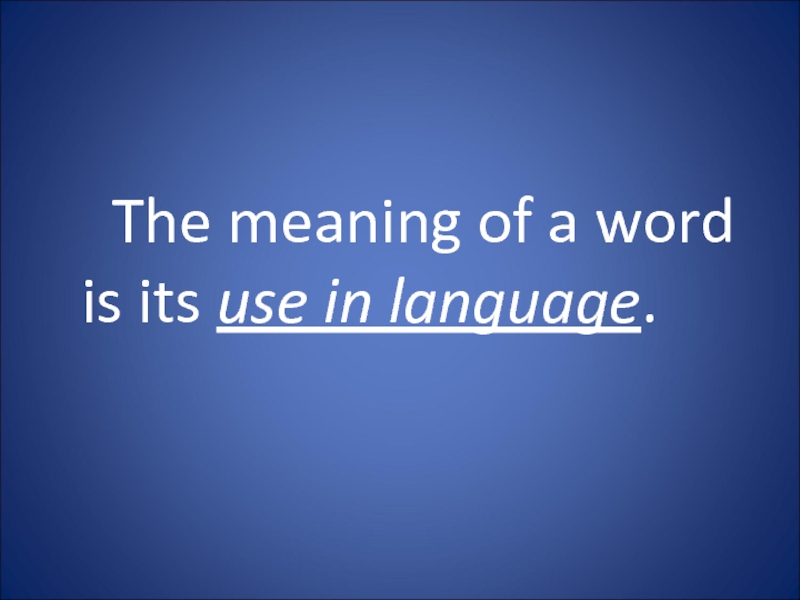
Слайд 28cloud and cloudy
have different meanings because in speech they function
differently and occupy different positions in relation to other words.
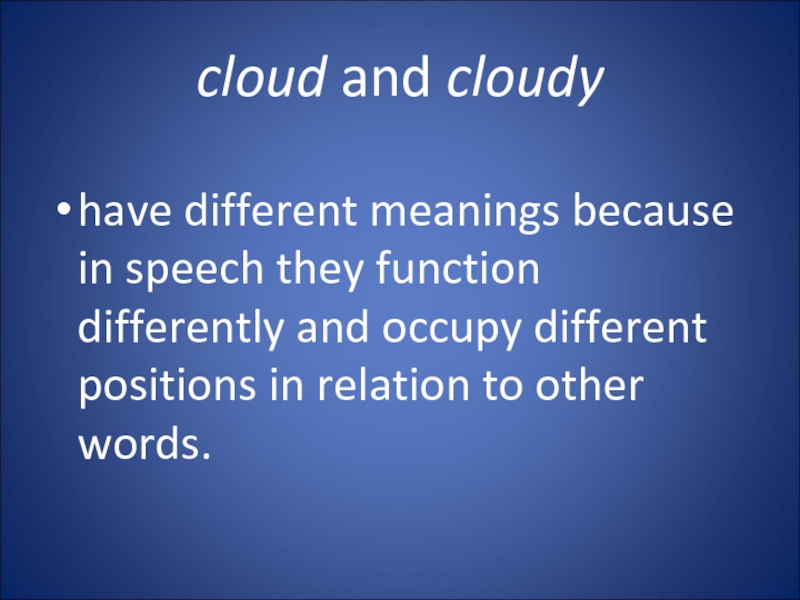
Слайд 29Meaning:
a component of the word through which a concept
is communicated
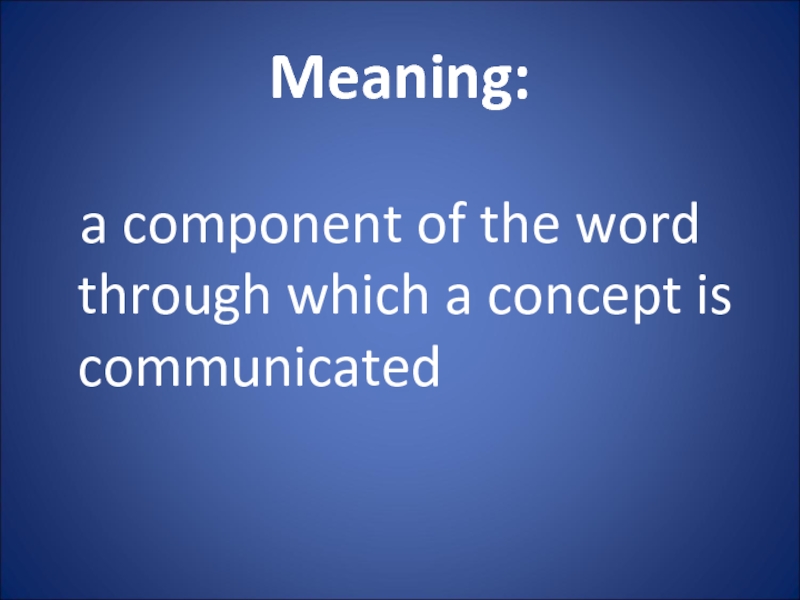
Слайд 31According to the conception of word meaning as a specific structure:
functional
meaning: part of speech meaning (nouns usually denote «thingness», adjectives – qualities and states)
grammatical: found in identical sets of individual forms of different words (she goes/works/reads, etc.)
lexical: the component of meaning proper to the word as a linguistic unit highly individual and recurs in all the forms of a word (the meaning of the verb to work ‘to engage in physical or mental activity’ that is expressed in all its forms: works, work, worked, working, will work)
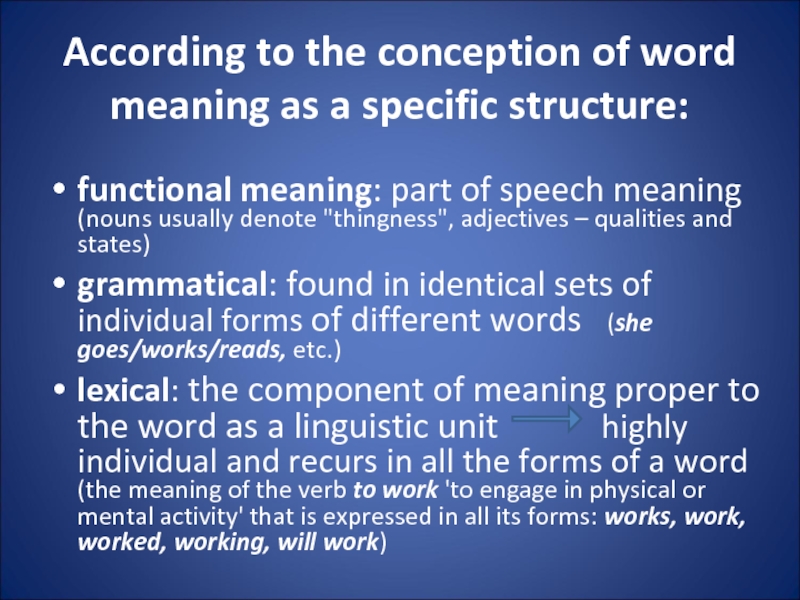
Слайд 32Lexical Meaning:
denotational
connotational
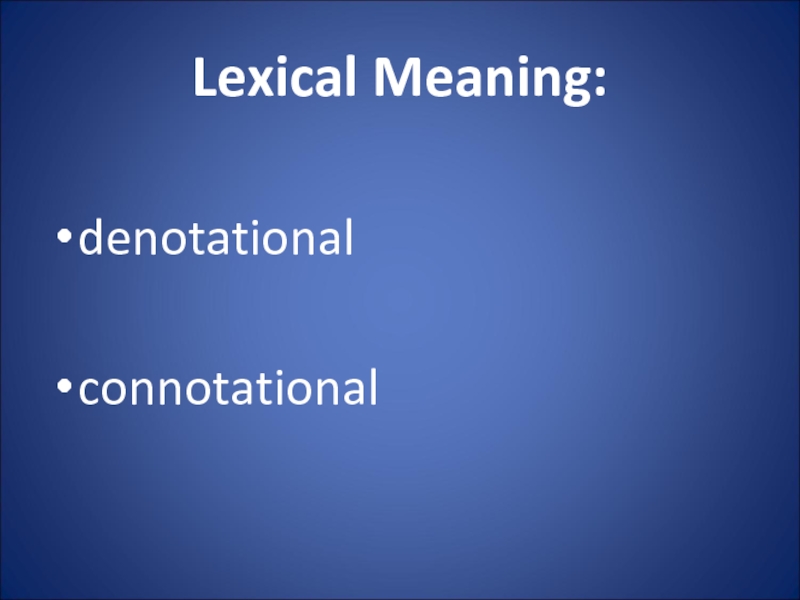
Слайд 33
Denotational lexical meaning provides correct reference of a word to an
individual object or a concept.
It makes communication possible and is explicitly revealed in the dictionary definition (chair ‘a seat for one person typically having four legs and a back’).

Слайд 35
Connotational lexical meaning is an emotional colouring of the
word. Unlike denotational meaning, connotations are optional.
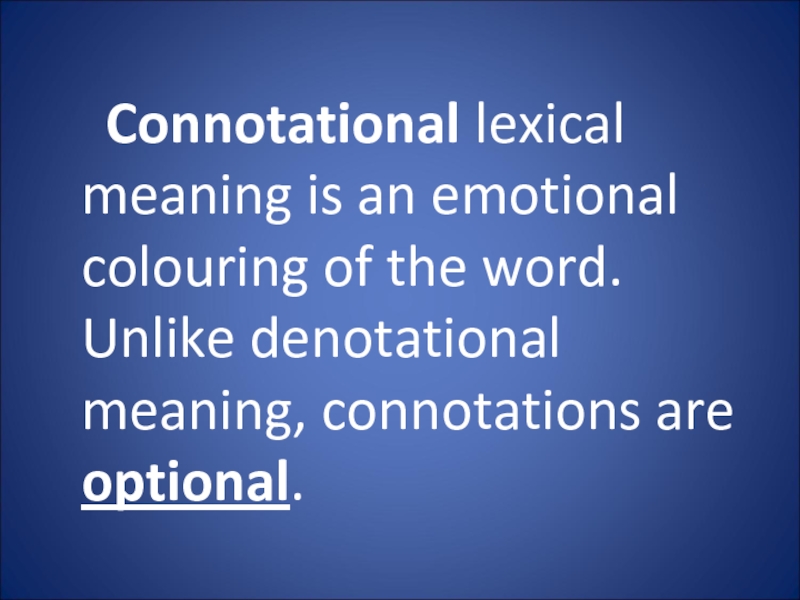
Слайд 36Connotations:
Emotive charge may be inherent in word meaning (like in attractive,
repulsive) or may be created by prefixes and suffixes (like in piggy, useful, useless).
It’s always objective because it doesn’t depend on a person’s perception.
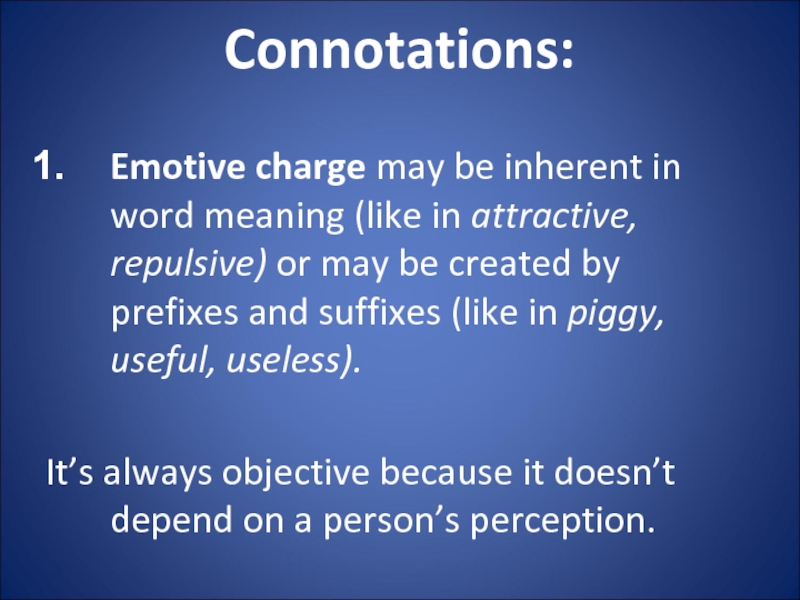
Слайд 37
2. Stylistic reference refers the word to a certain style:
neutral words
colloquial
bookish,
or literary words
Eg. father – dad – parent .
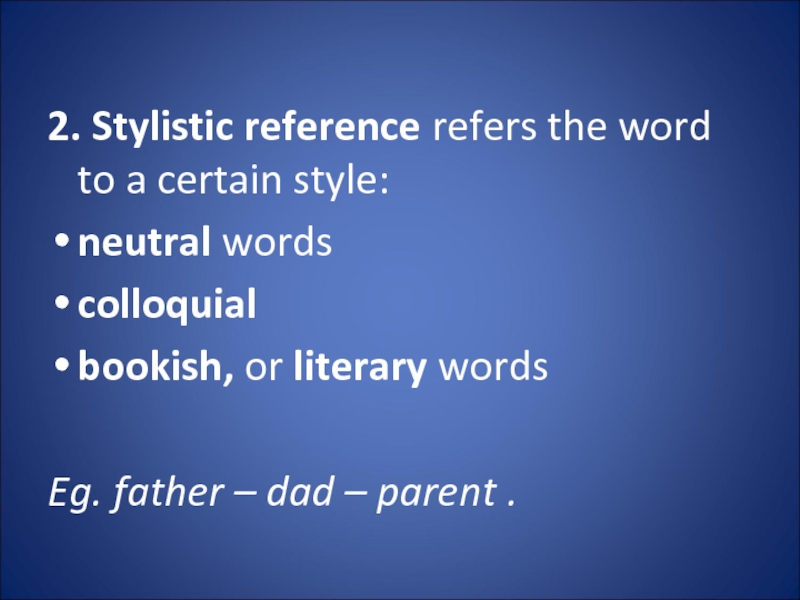
Слайд 38
3. Evaluative connotations express approval or disapproval (charming, disgusting).
4. Intensifying connotations
are expressive and emphatic (magnificent, gorgeous)

Слайд 39
Denotative component
Lonely = alone, without company
To glare = to look
Connotative component
+ melancholy, sad (emotive con.)
+ 1) steadily, lastingly (con. of duration)
+ 2) in anger, rage (emotive con.)
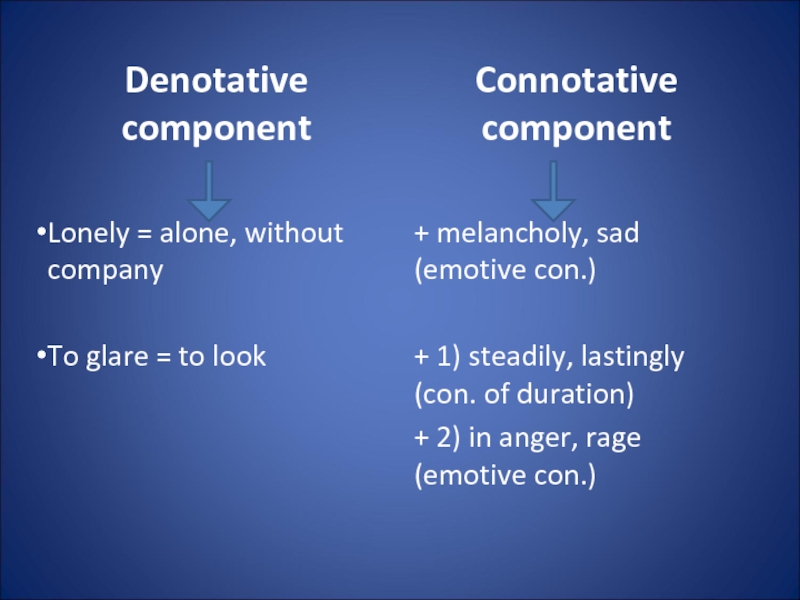
Слайд 40
3. Polysemy. Semantic structure of words. Meaning and context
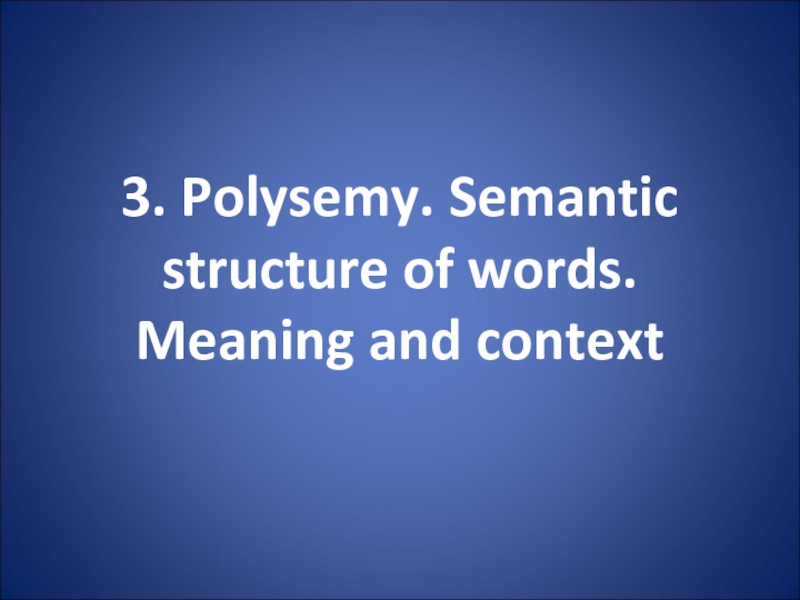
Слайд 41
A polysemantic word is a word having more than one meaning.
Polysemy
is the ability of words to have more than one meaning.
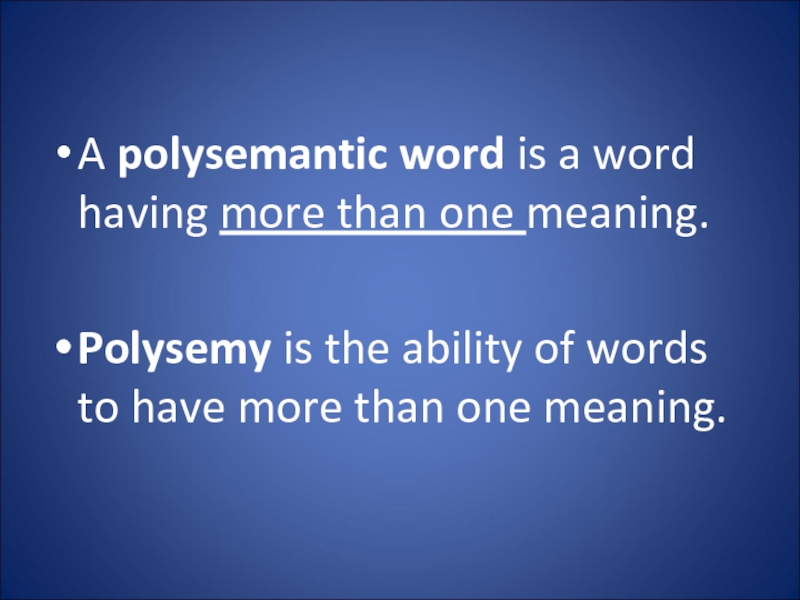
Слайд 42
Most English words are polysemantic.
A well-developed polysemy is a great advantage in a language.
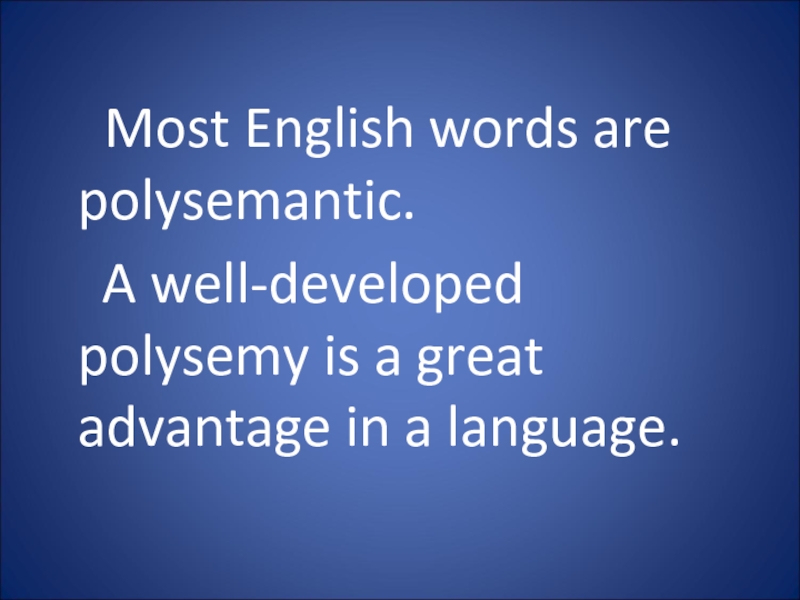
Слайд 43Monosemantic Words:
terms (synonym, bronchitis, molecule),
pronouns (this, my, both),
numerals, etc.
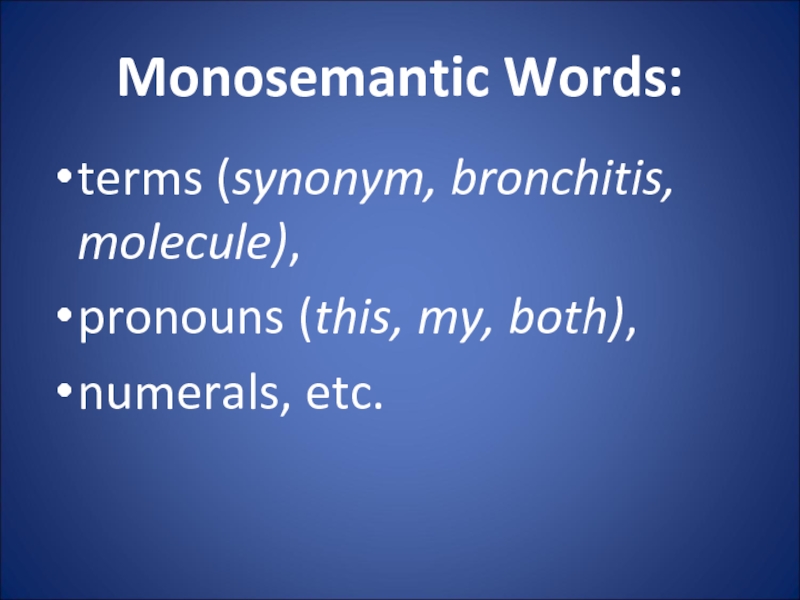
Слайд 44The main causes of polysemy:
a large number of:
1) monosyllabic words;
2) words of long duration (that existed for centuries).
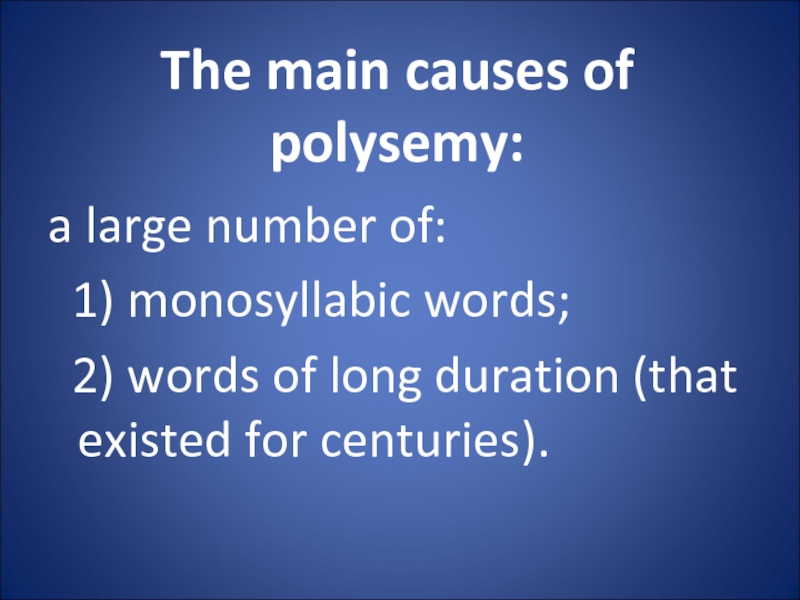
Слайд 45The sources of polysemy:
1) the process of meaning change (meaning specialization:
is used in more concrete spheres);
2) figurative language (metaphor and metonymy);
3) homonymy;
4) borrowing of meanings from other languages.
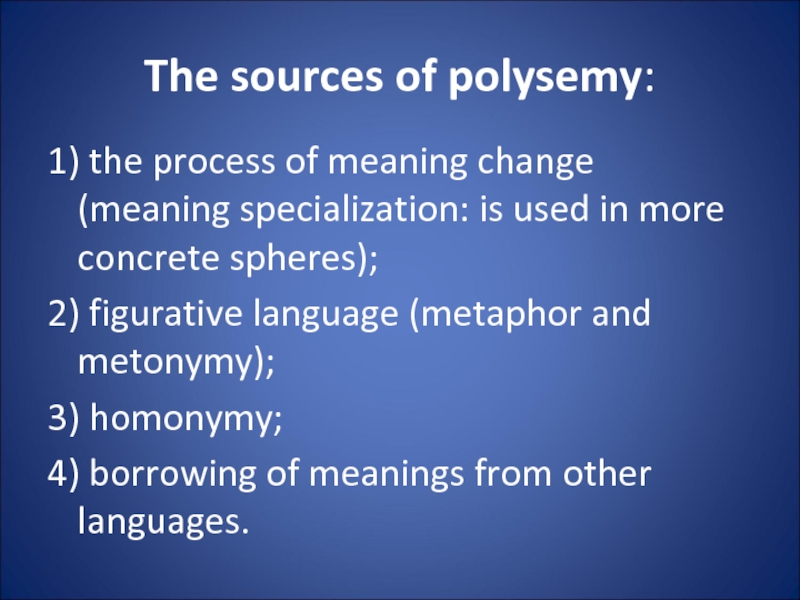
Слайд 46blanket
a woolen covering used on beds,
a covering for keeping a house
warm,
a covering of any kind (a blanket of snow),
covering in most cases (used attributively), e.g. we can say: a blanket insurance policy.
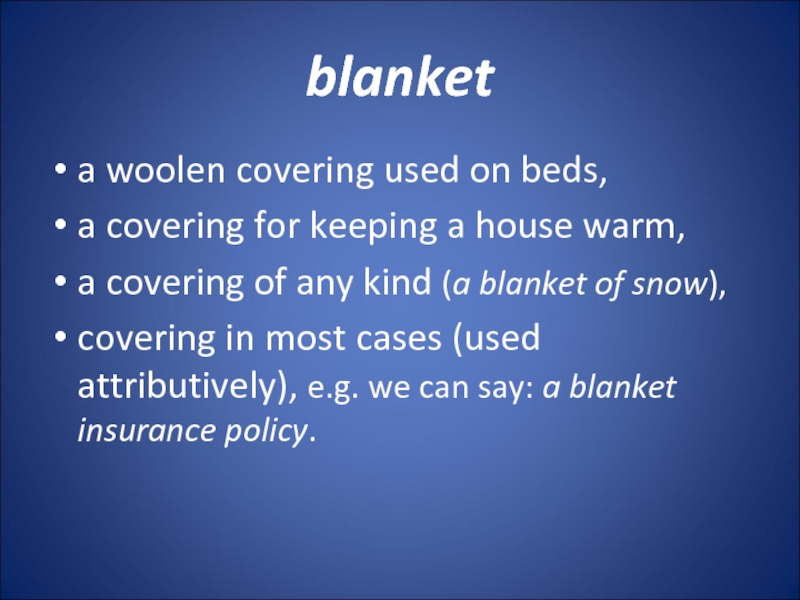
Слайд 47
Meanings of a polysemantic word are organized in a
semantic structure
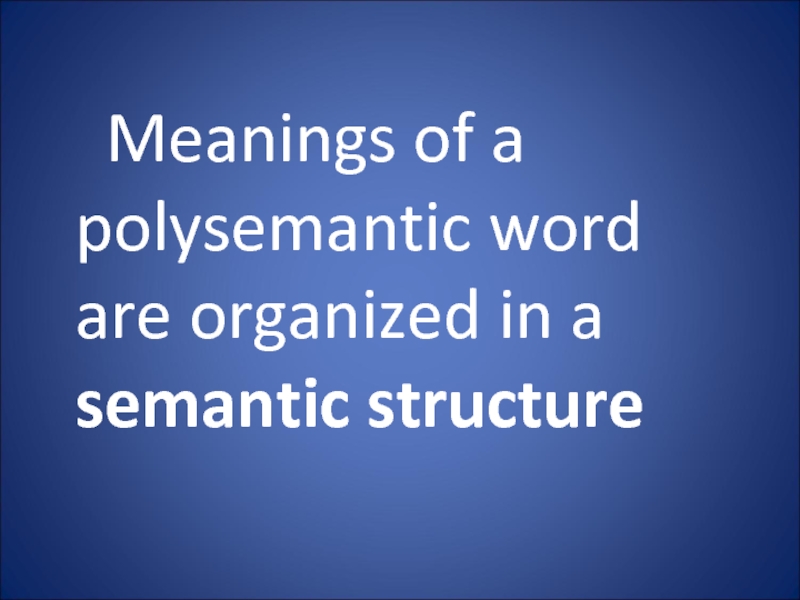
Слайд 48Lexical-semantic variant
one of the meanings of a polysemantic word used
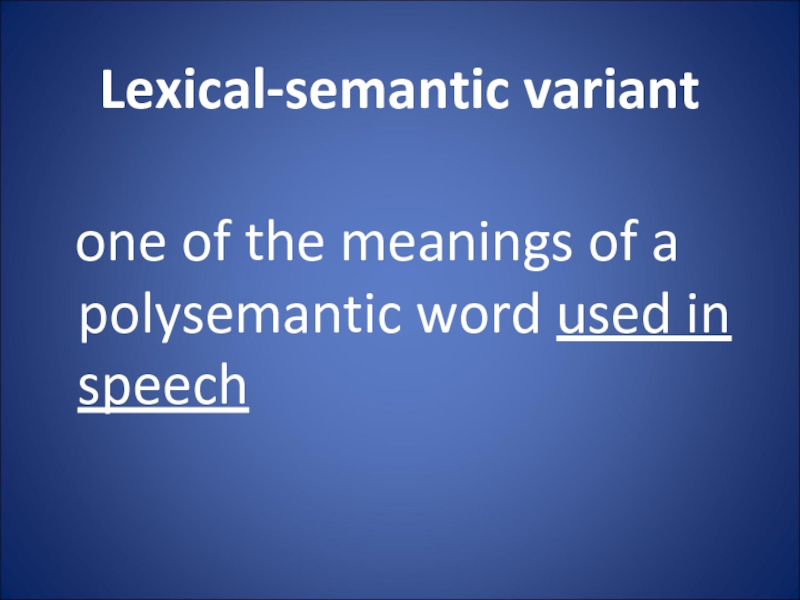
Слайд 49A Word’s Semantic Structure Is Studied:
Diachronically (in the process of its
historical development): the historical development and change of meaning becomes central. Focus: the process of acquiring new meanings.
Synchronically (at a certain period of time): a co-existence of different meanings in the semantic structure of the word at a certain period of language development. Focus: value of each individual meaning and frequency of its occurrence.
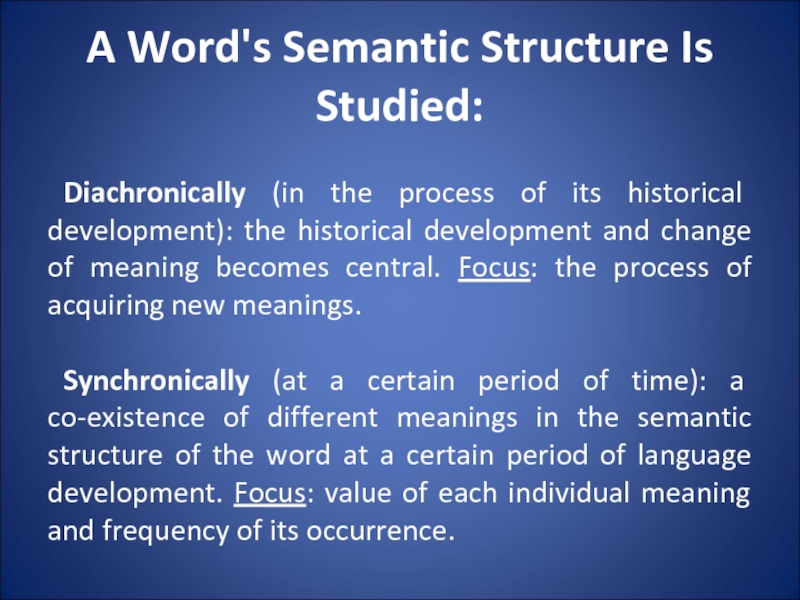
Слайд 50
The meaning first registered in the language is called primary.
Other
meanings are secondary, or derived, and are placed after the primary one.
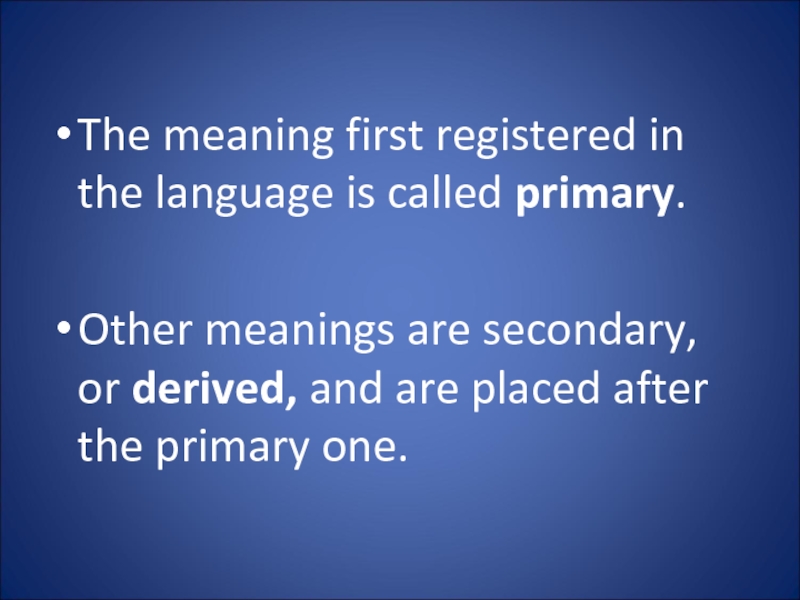
Слайд 51table
a piece of furniture (primary meaning)
the persons
seated at the table
the food put on the table, meals
a thin flat piece of stone, metal, wood
slabs of stone
words cut into them or written on them
an orderly arrangement of facts
part of a machine-tool on which the work is put to be operated on
a level area, a plateau
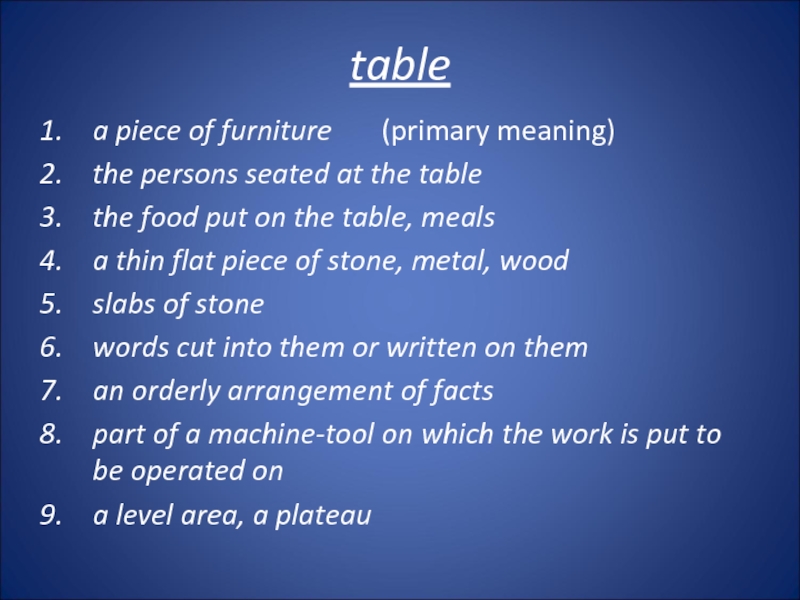
Слайд 52
The meaning that first occurs to our mind, or is understood
without a special context is called the basic or main meaning.
Other meanings are called peripheral or minor.
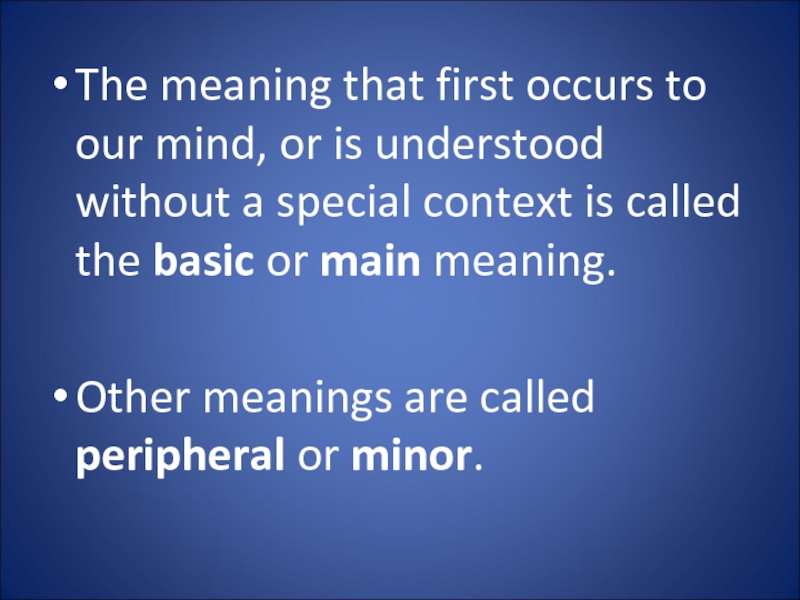
Слайд 53Fire
1. flame (main meaning)
2. an instance of destructive burning
e.g. a forest fire
4. the shooting of guns
e.g. to open fire
3. burning material in a stone, fireplace
e.g. a camp fire
5. strong feeling, passion
e.g. speech lacking fire

Слайд 54Processes of the Semantic Development of a Word:
radiation (the primary meaning
stands in the center and the secondary meanings proceed out of it like rays. Each secondary meaning can be traced to the primary meaning)
concatenation (secondary meanings of a word develop like a chain. It is difficult to trace some meanings to the primary one)
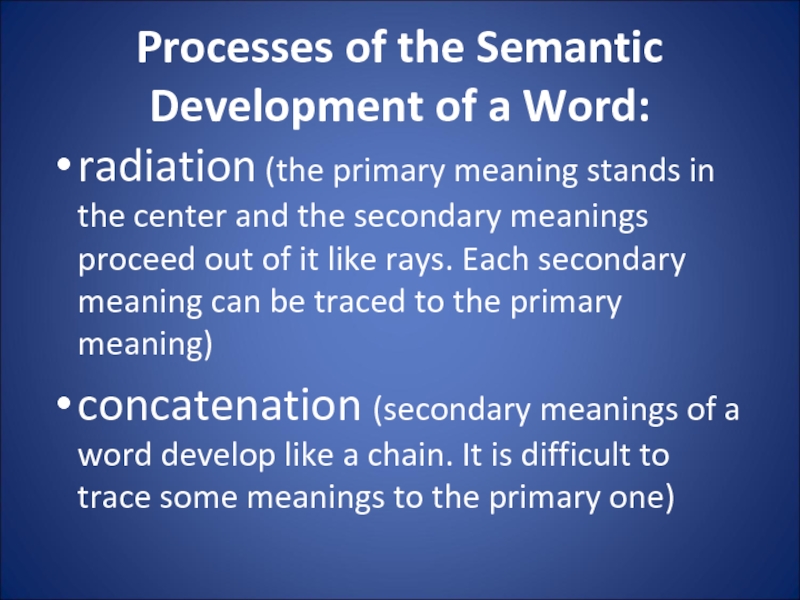
Слайд 55crust
hard outer part of bread
hard part of anything (a
pie, a cake)
harder layer over soft snow
a sullen gloomy person
Impudence
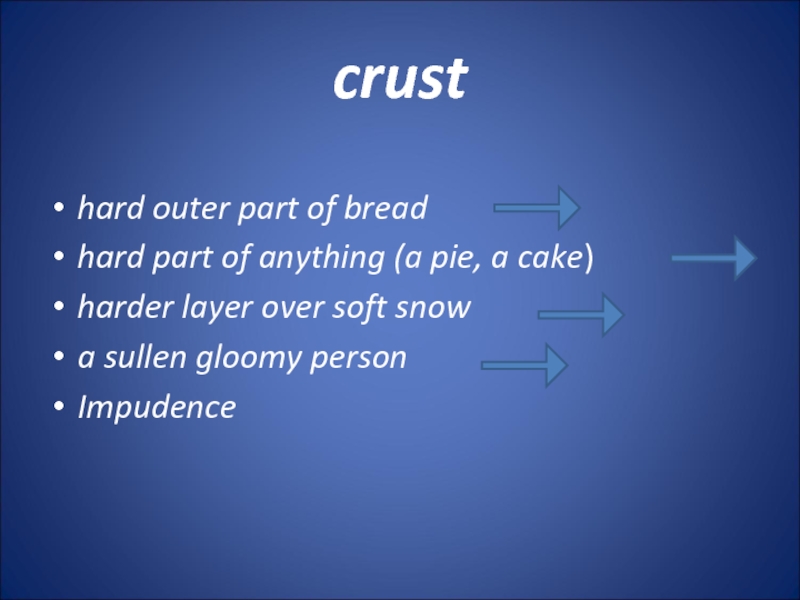
Слайд 56
Polysemy exists not in speech but in the language.
It’s
easy to identify the main meaning of a separate word. Other meanings are revealed in context.
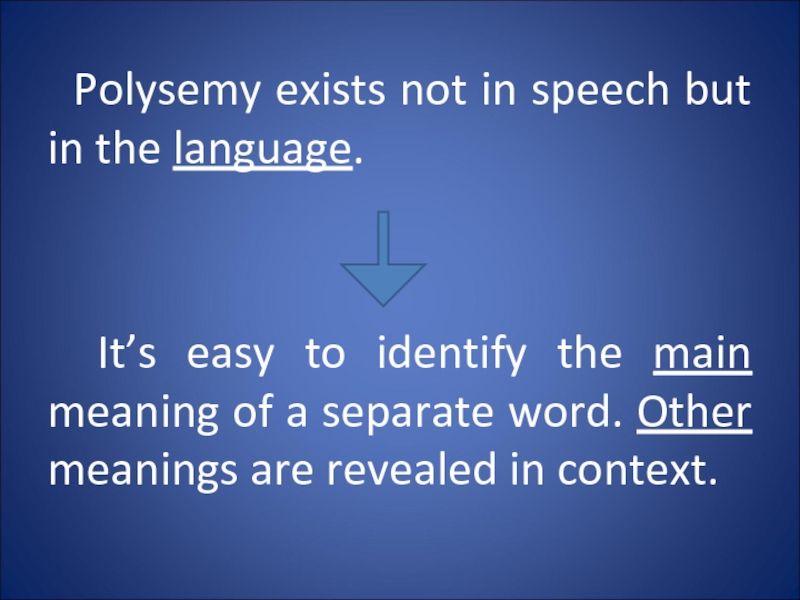
Слайд 57Context:
linguistic
1. lexical – a number of lexical units
around the word which enter into interaction with it (i.e. words combined with a polysemantic word are important).
2. grammatical – a number of lexical units around the world viewed on the level of parts of speech.
3. thematic – a very broad context, sometimes a text or even a book.
extralinguistic – different cultural, social, historical factors
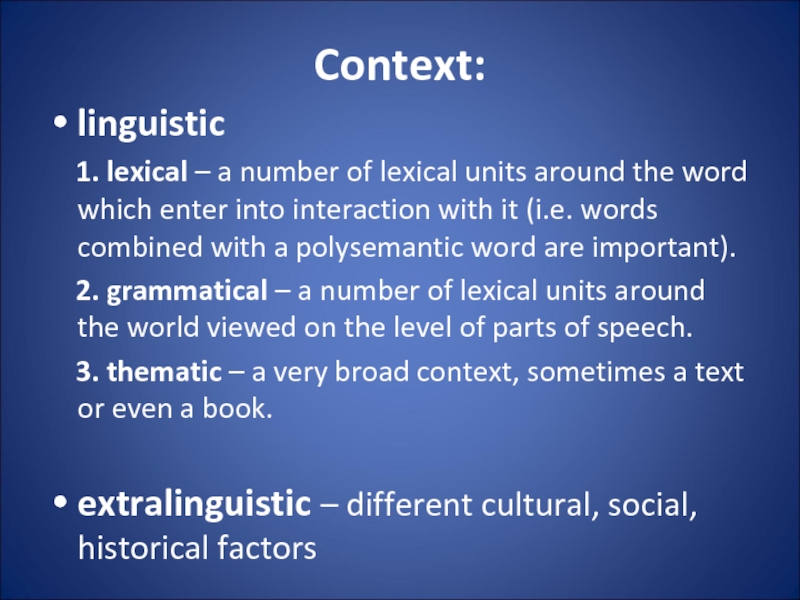
Слайд 58
4. Change of word-meaning: the causes, nature and results
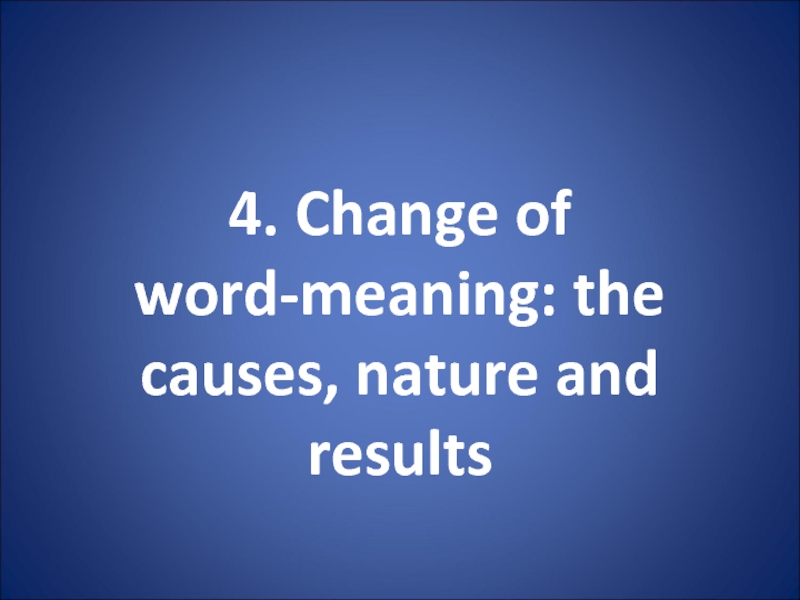
Слайд 59
The meaning of a word can change in a course
of time.
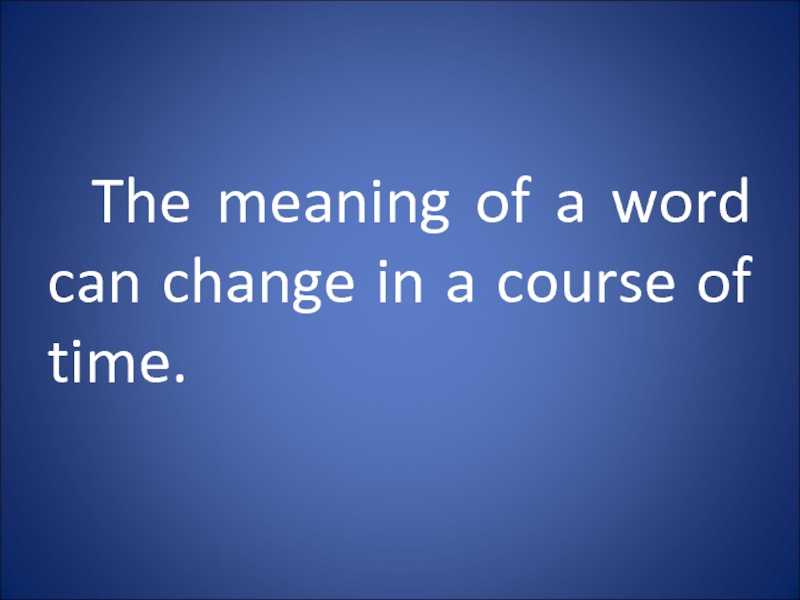
Слайд 60Causes of Change of
Word-meaning:
1. Extralinguistic (various changes in the life
of a speech community, in economic and social structure, in ideas, scientific concepts)
e.g. “car” meant ‘a four-wheeled wagon’; now – ‘a motor-car’, ‘a railway carriage’ (in the USA)
“paper” is not connected anymore with “papyrus” – the plant from which it formerly was made.
2. Linguistic (factors acting within the language system)
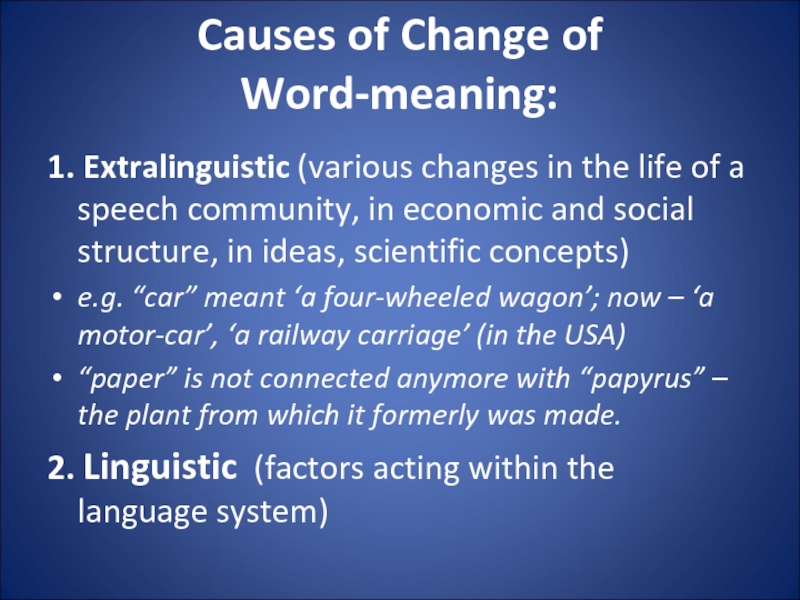
Слайд 61Linguistic Causes:
1. ellipsis – in a phrase made up of two
words one of these is omitted and its meaning is transferred to its partner.
e.g. “to starve” in O.E. = ‘to die’ + the word “hunger”. In the 16th c. “to starve” = ‘to die of hunger’.
e.g. daily = daily newspaper
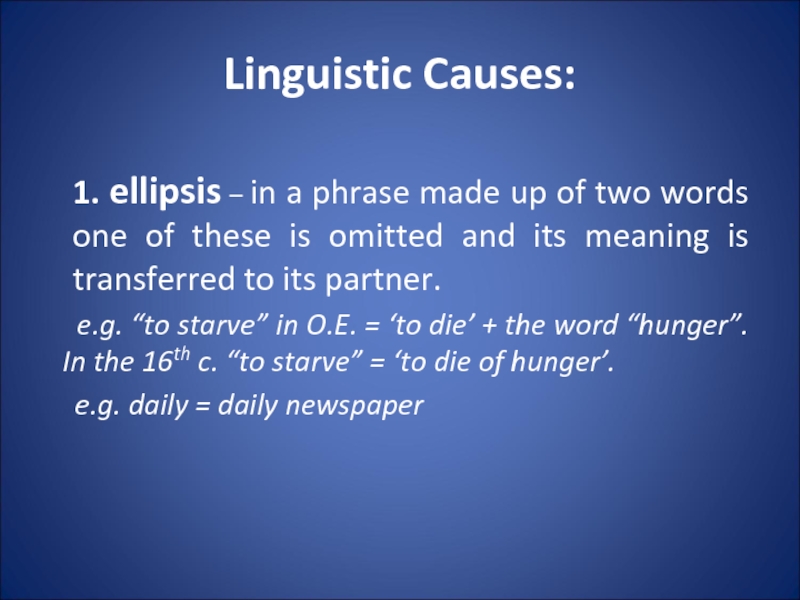
Слайд 62Linguistic Causes:
2. differentiation (discrimination) of synonyms – when a new
word is borrowed it may become a perfect synonym for the existing one. They have to be differentiated; otherwise one of them will die.
e.g. “land” in O.E. = both ‘solid part of earth’s surface’ and ‘the territory of the nation’. In the middle E. period the word “country” was borrowed as its synonym; ‘the territory of a nation’ came to be denoted mainly by “country”.
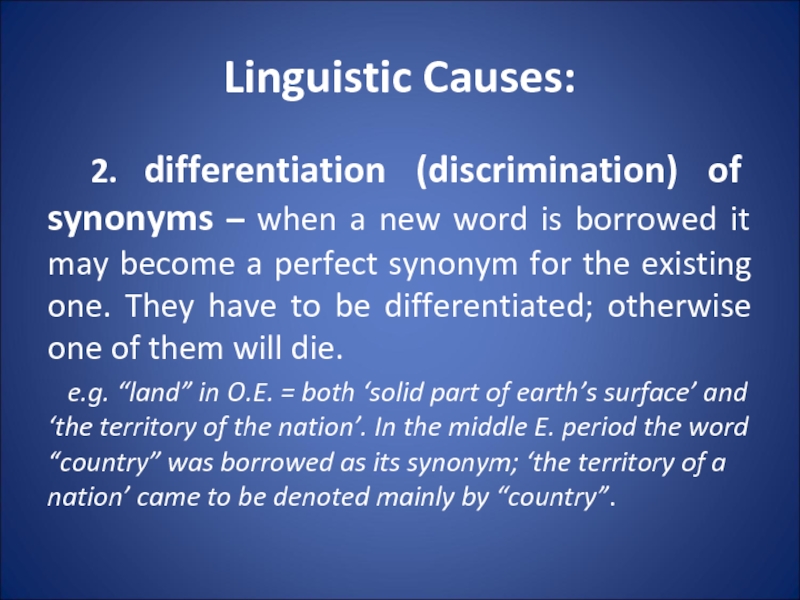
Слайд 63Linguistic Causes:
3. linguistic analogy – if one of the members of
the synonymic set acquires a new meaning, other members of this set change their meaning too.
e.g. “to catch” acquired the meaning ‘to understand’; its synonyms “to grasp” and “to get” acquired this meaning too.

Слайд 64
The nature of semantic changes is based on the
secondary application of the word form to name a different yet related concept.
Conditions to any semantic change: some connection between the old meaning and the new.
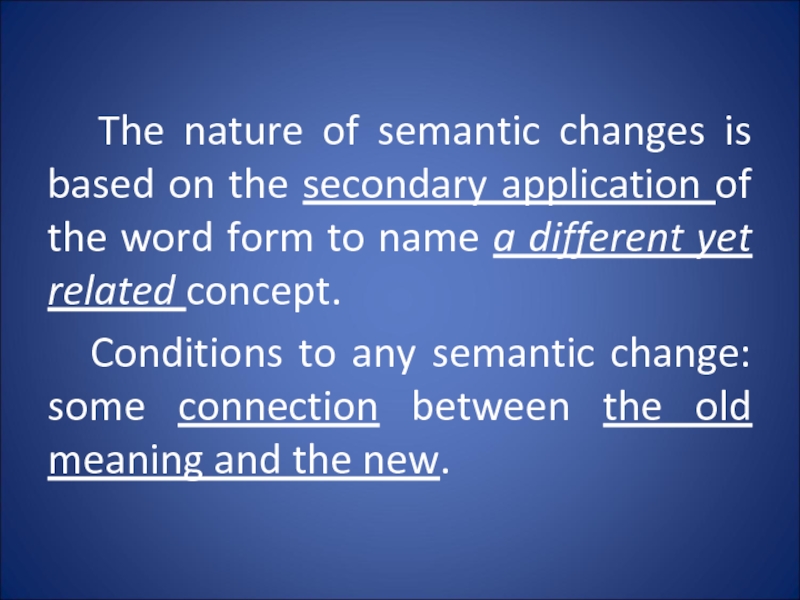
Слайд 65Association between Old Meaning and New:
similarity of meanings or metaphor –
a semantic process of associating two referents one of which in some way resembles the other
contiguity (closeness) of meanings or metonymy – a semantic process of associating two referents one of which makes part of the other or is closely connected with it
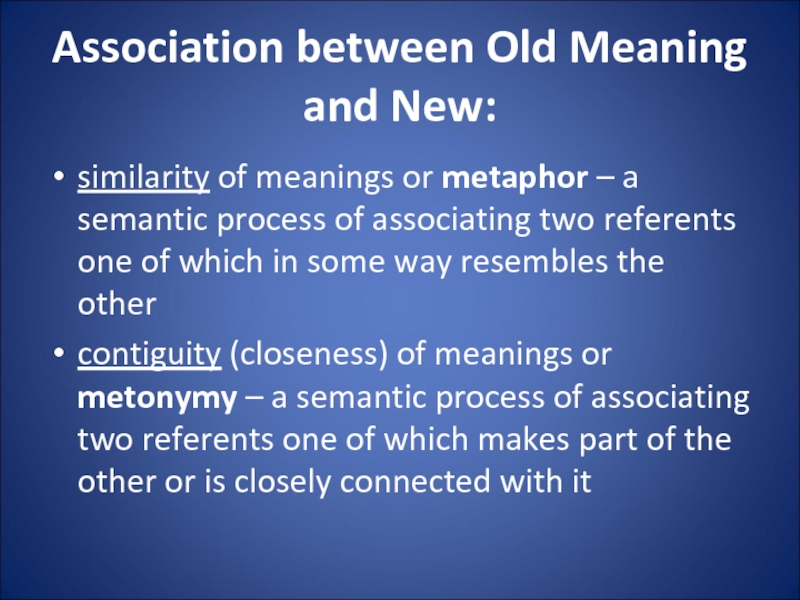
Слайд 66Types of Metaphor:
a) similarity of shape, e.g. head (of a cabbage),
bottleneck, teeth (of a saw, a comb);
b) similarity of position, e.g. foot (of a page, of a mountain), head (of a procession);
c) similarity of function, behavior, e.g. a bookworm (a person who is fond of books);
d) similarity of color, e.g. orange, hazel, chestnut.
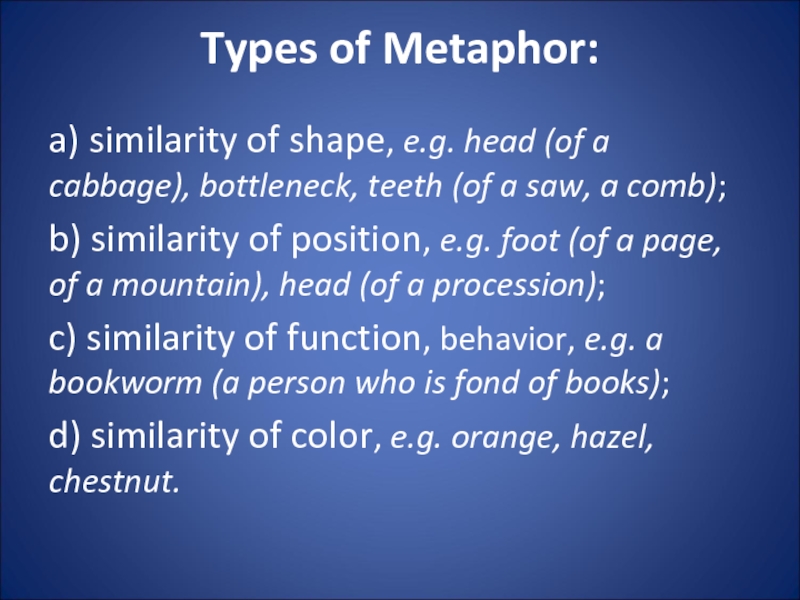
Слайд 67Types of Metonymy:
‘material — object of it’ (She is wearing a
fox);
‘container — containее’ (I ate three plates);
‘place — people’ (The city is asleep);
‘object — a unit of measure’ (This horse came one neck ahead);
‘producer — product’ (We bought a Picasso);
‘whole — part’ (We have 10 heads here);
‘count — mass’ (We ate rabbit)
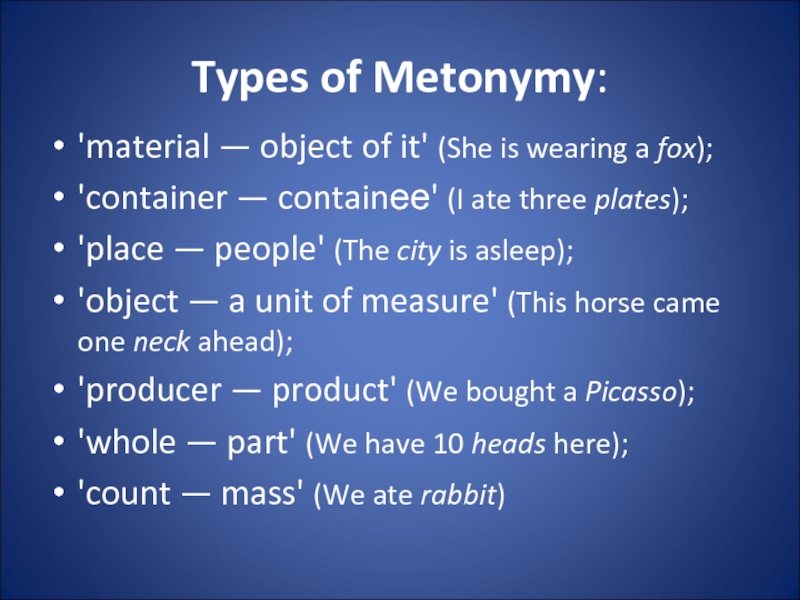
Слайд 68Results of Semantic Change:
changes in the denotational component
changes in the connotational
meaning
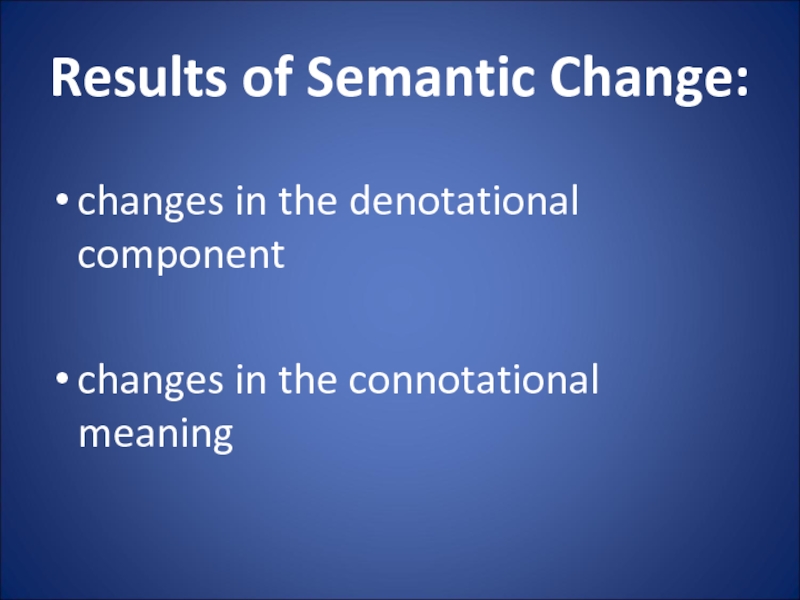
Слайд 69Changes in the Denotational Component:
restriction – a word denotes a restricted
number of referents.
e.g. “fowl” in O.E. = ‘any bird’, but now ‘a domestic hen or chicken’
extension – the application of the word to a wider variety of referents
e.g. ‘‘a cook’’ was not applied to women until the 16th century.
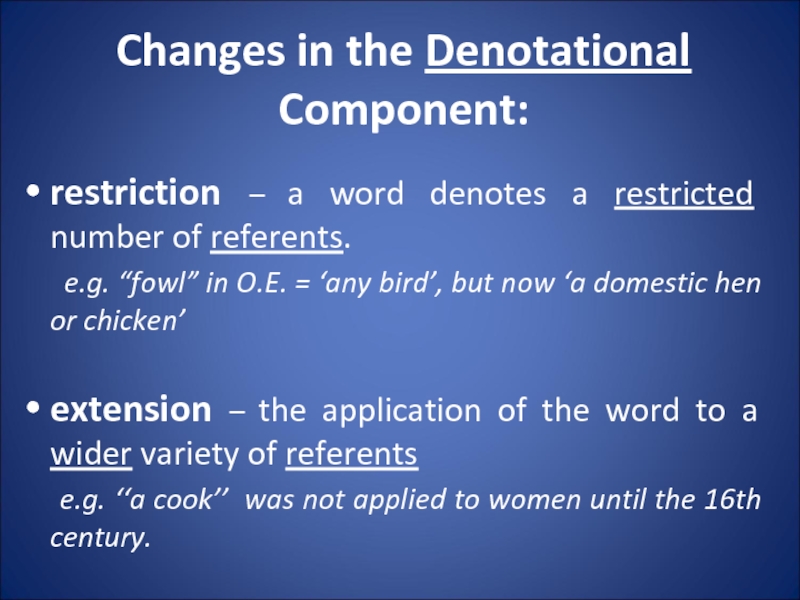
Слайд 70
generalization – the word with the extended meaning passes from the
specialized vocabulary into common use and the meaning becomes more general.
e.g. “camp” = ‘the place where troops are lodged in tents’; now – ‘temporary quarters’.
specialization – the word with the new meaning comes to be used in the specialized vocabulary of some limited group.
e.g. “to glide” = ‘to move gently and smoothly’ and now has acquired a special meaning – ‘to fly with no engine’.
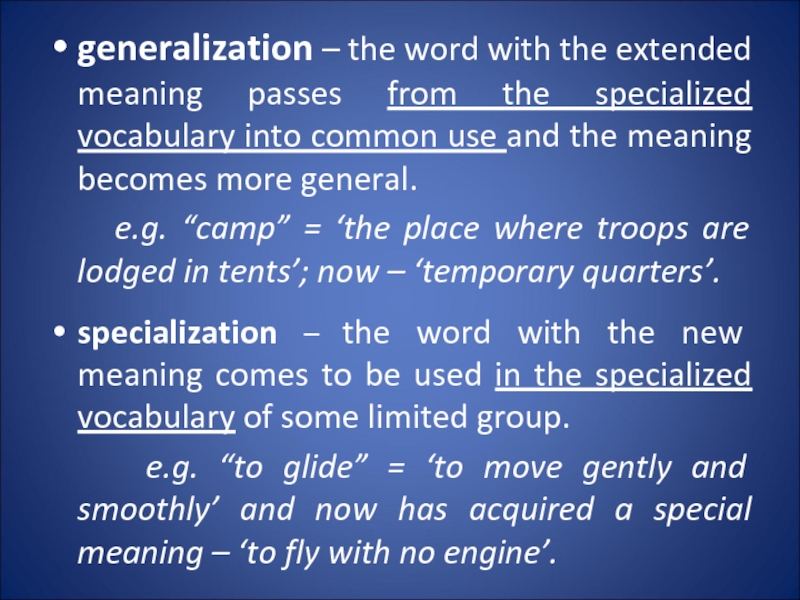
Слайд 71Changes in the Connotational Meaning:
pejorative development (degradation) – the acquisition by
the word of some derogatory emotive charge.
e.g. “accident” ‘a happening causing loss or injury’ came from more neutral ‘something that happened’;
ameliorative development (elevation) – the improvement of the connotational component of meaning.
e.g. “a minister” denoted a servant, now – ‘a civil servant of higher rank, a person administering a department of state’
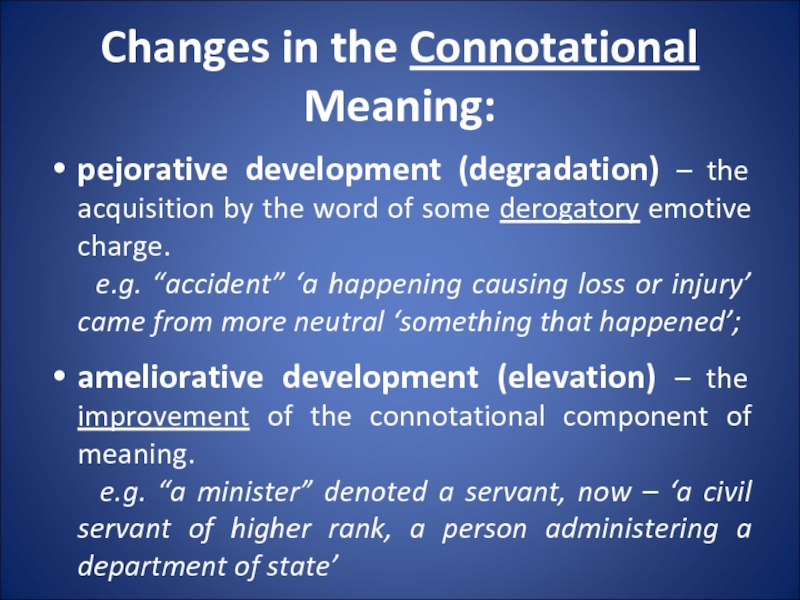
Слайд 72List of Literature:
Антрушина, Г. Б. Лексикология английского языка: учебник для студ.
пед. ин-тов по спец. № 2103 «Иностр. яз.» / Г. Б. Антрушина, О. В. Афанасьева, Н. Н. Морозова; под ред. Г. Б. Антрушиной. – М.: Высш. школа, 1985. – С. 129–142, 147–160.
Воробей, А. Н. Глоссарий лингвистических терминов / А. Н. Воробей, Е. Г. Карапетова. – Барановичи: УО «БарГУ», 2004. – 108 с.
Дубенец, Э. М. Современный английский язык. Лексикология: пособие для студ. гуманит. вузов / Э. М. Дубенец. – М. / СПб.: ГЛОССА / КАРО, 2004. – С. 74–82, 123–127.
Лексикология английского языка: учебник для ин-тов и фак-тов иностр. яз. / Р. З. Гинзбург [и др.]; под общ. ред. Р. З. Гинзбург. – 2-е изд., испр. и доп. – М.: Высш. школа, 1979. – С. 13–23, 28–39, 47–51.
Лещева, Л. М. Слова в английском языке. Курс лексикологии современного английского языка: учебник для студ. фак-в и отдел. английского языка (на англ. яз.) / Л. М. Лещева. – Минск: Академия управления при Президенте Республики Беларусь, 2001. – С. 36–56.
